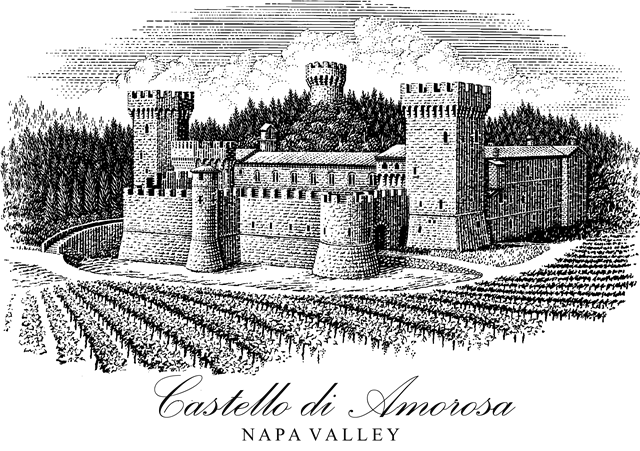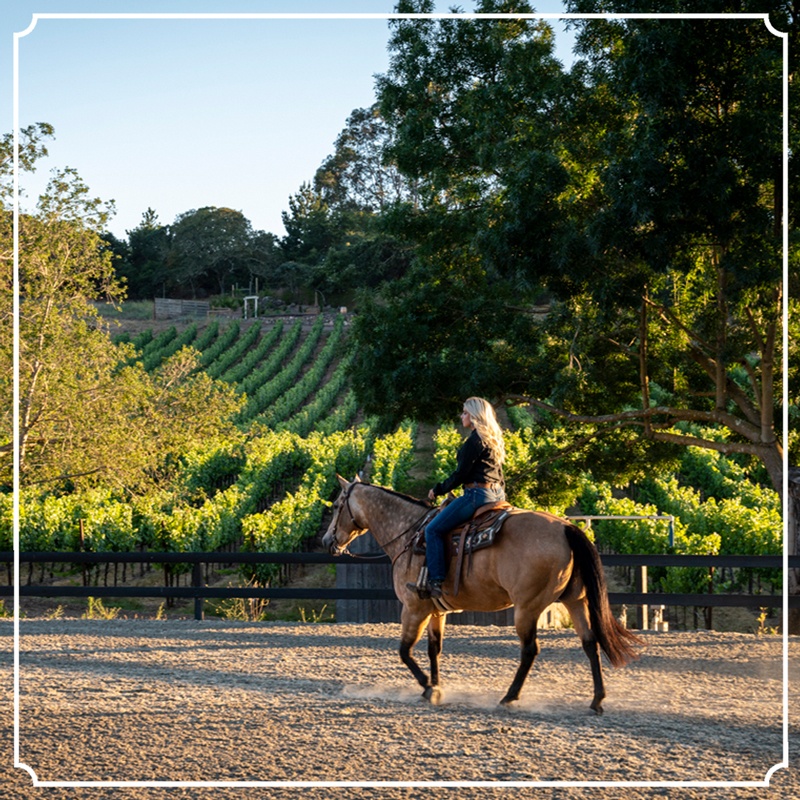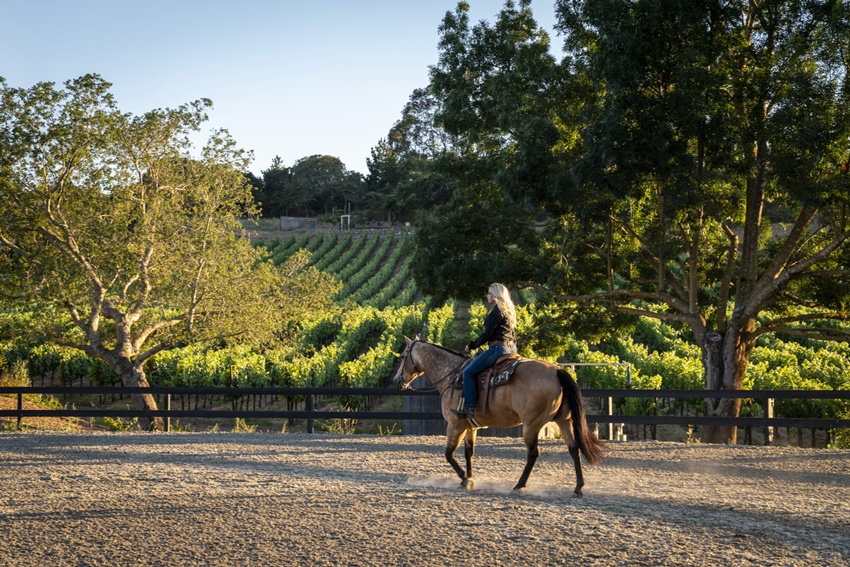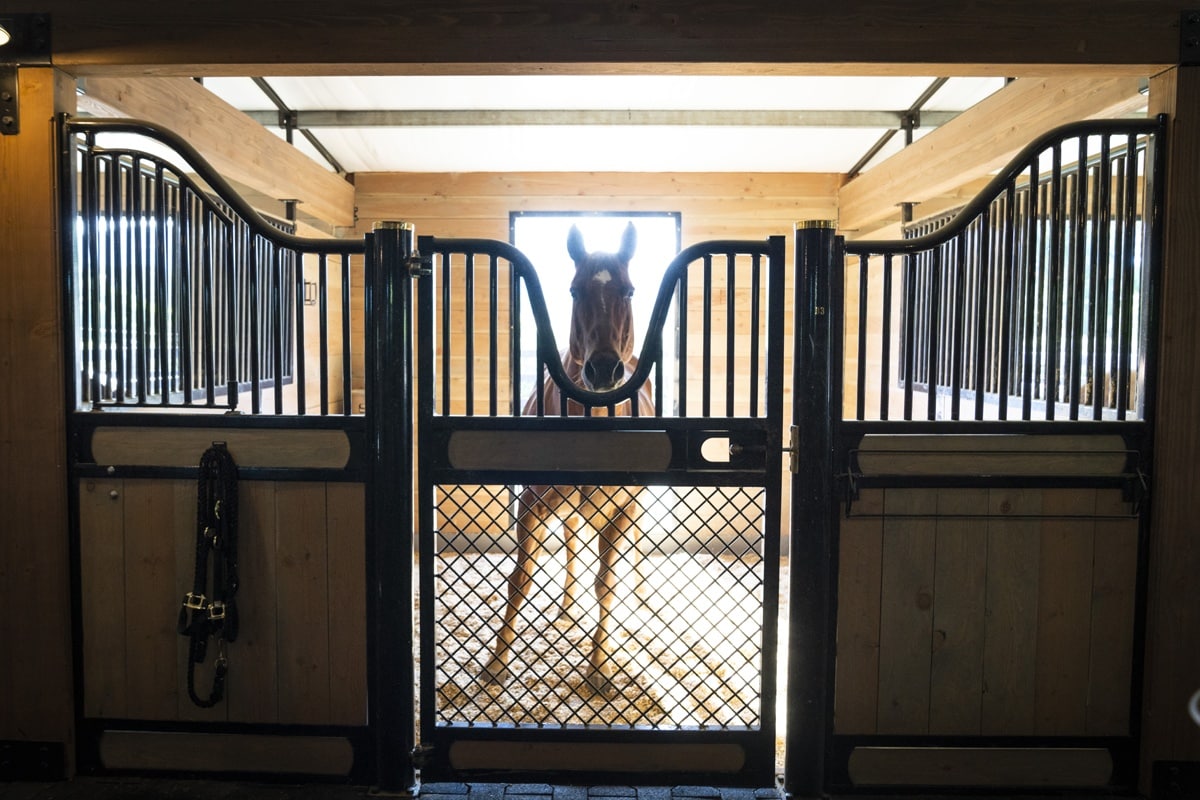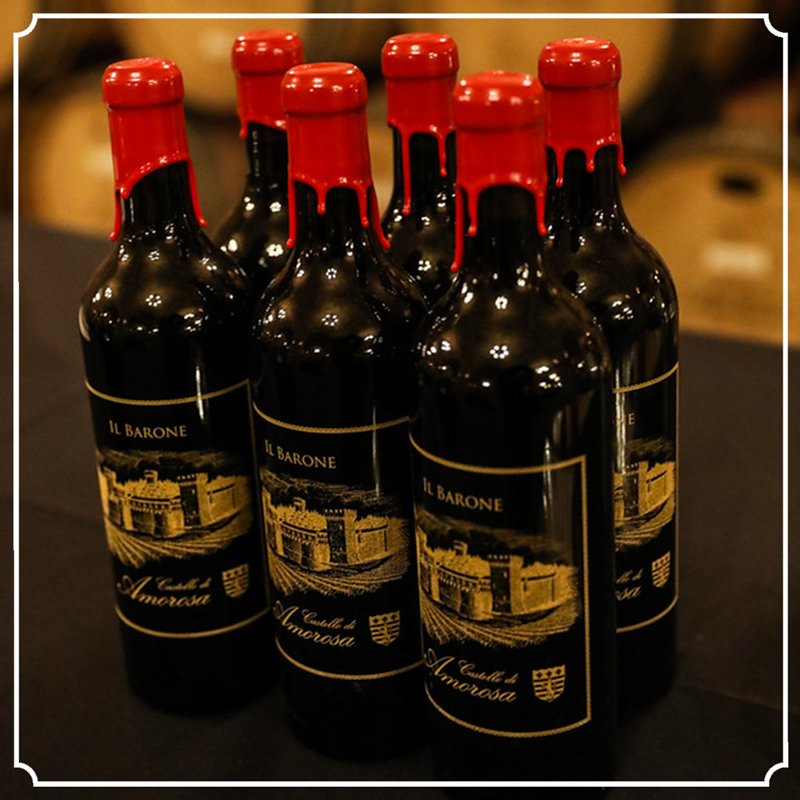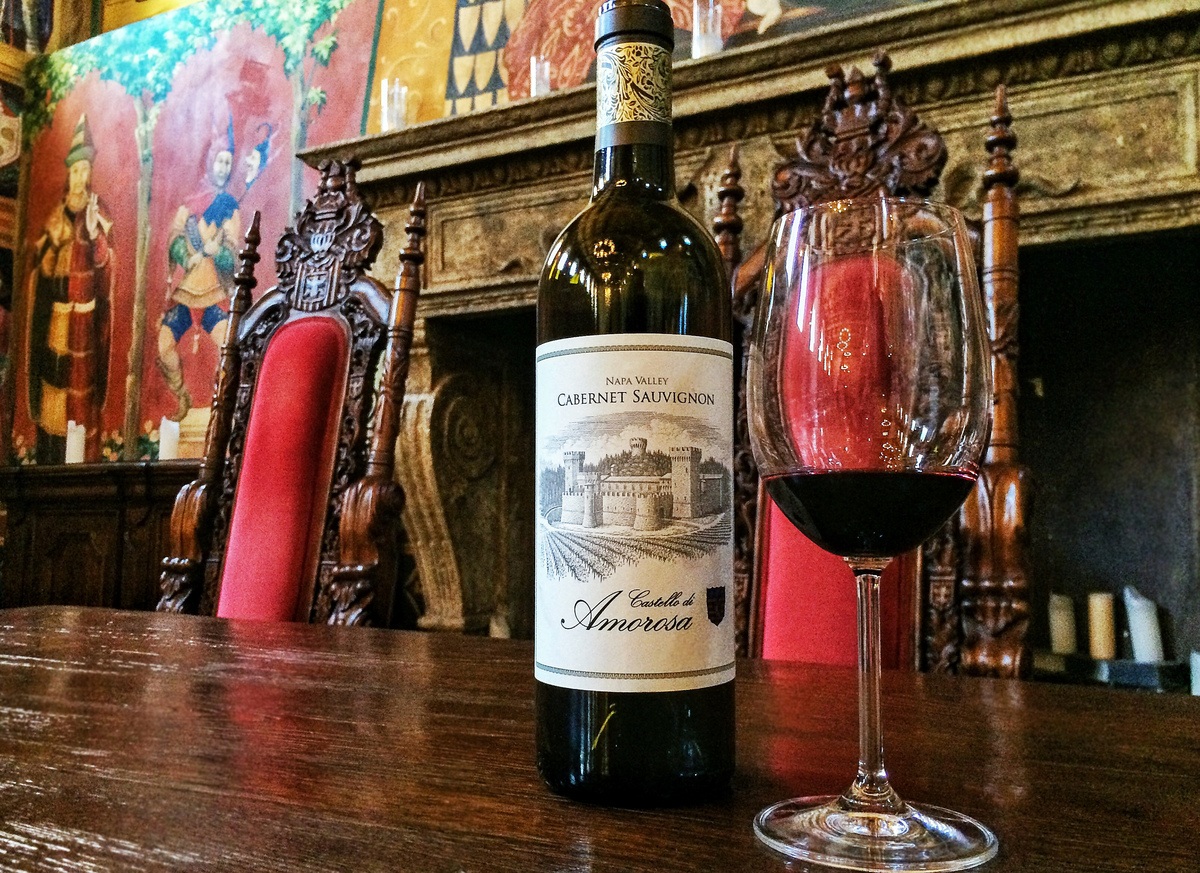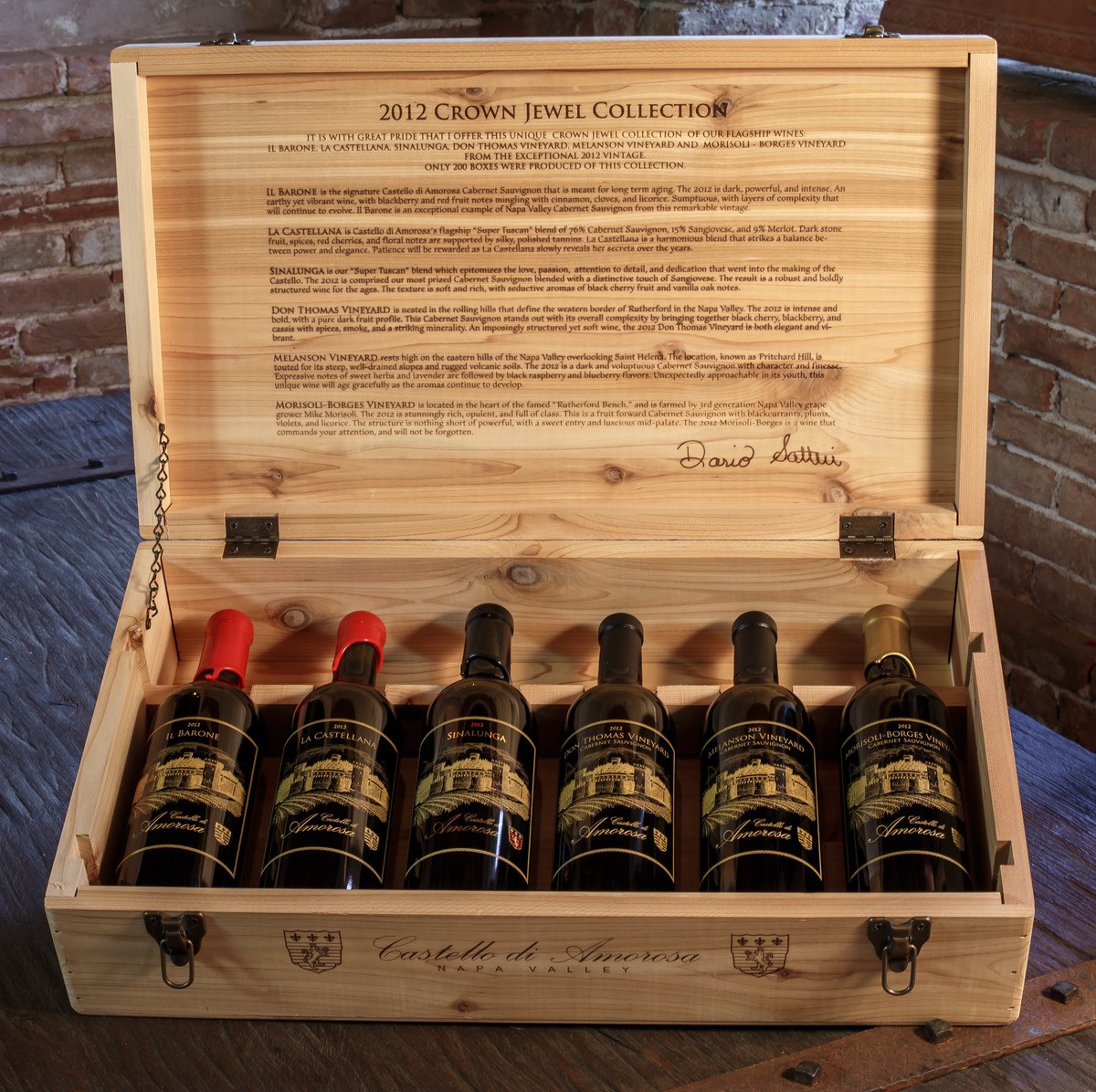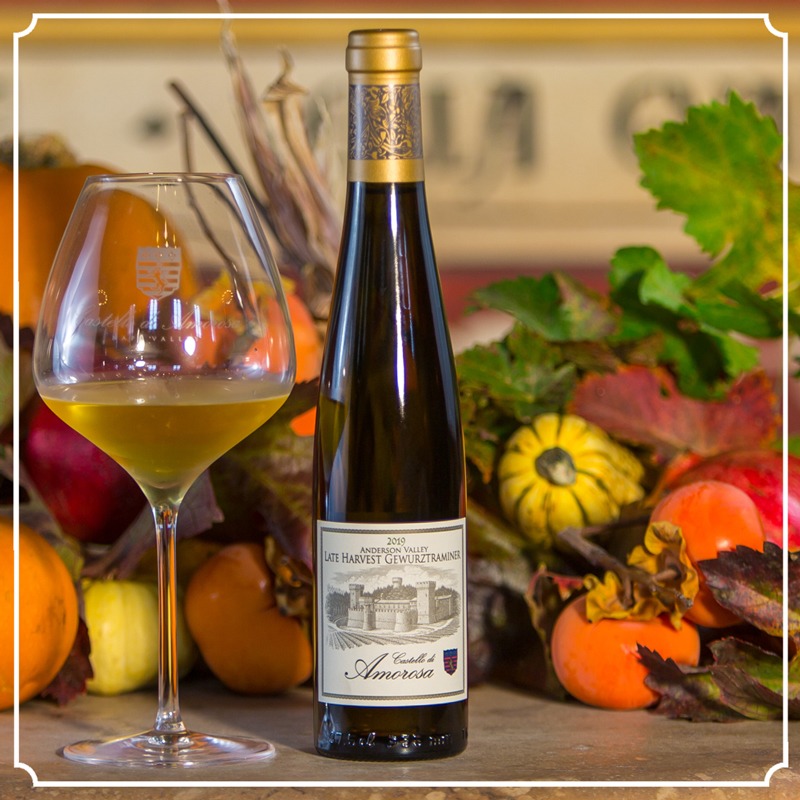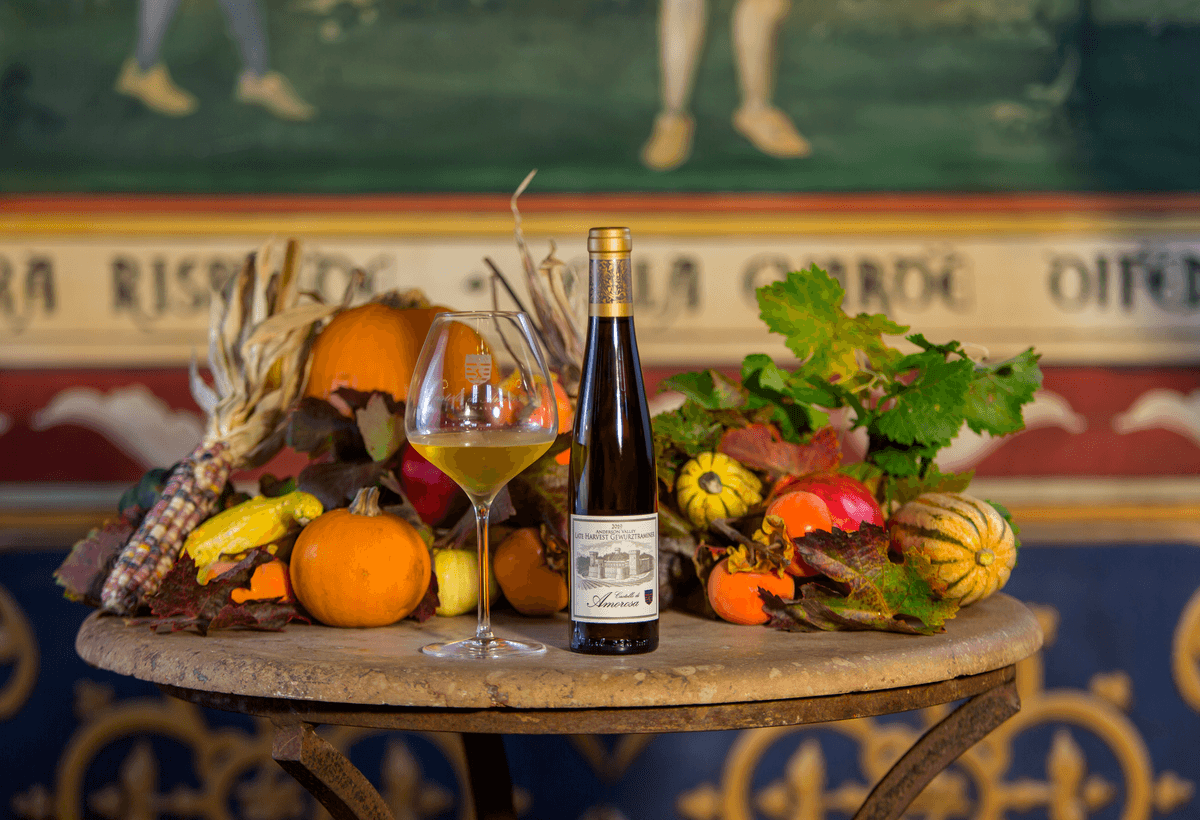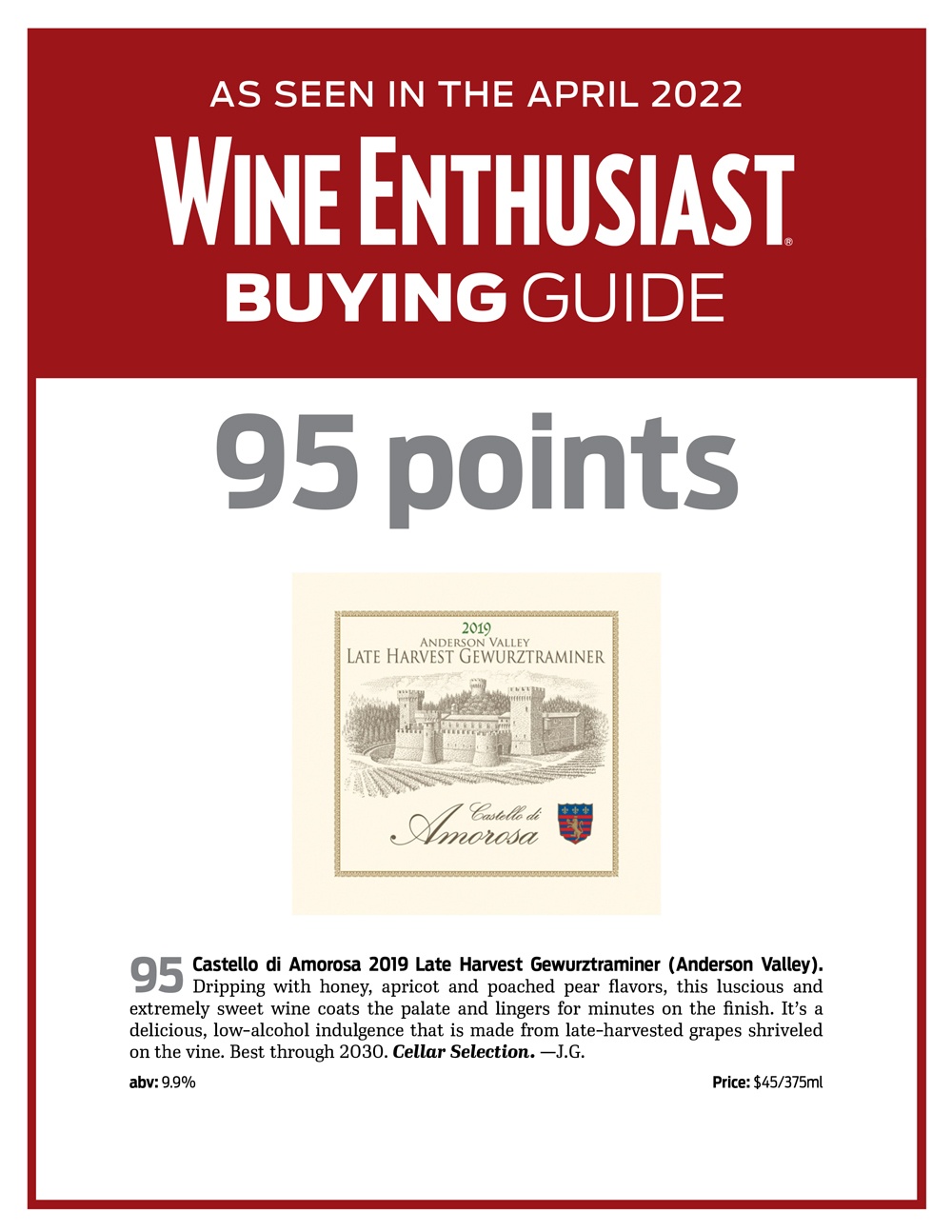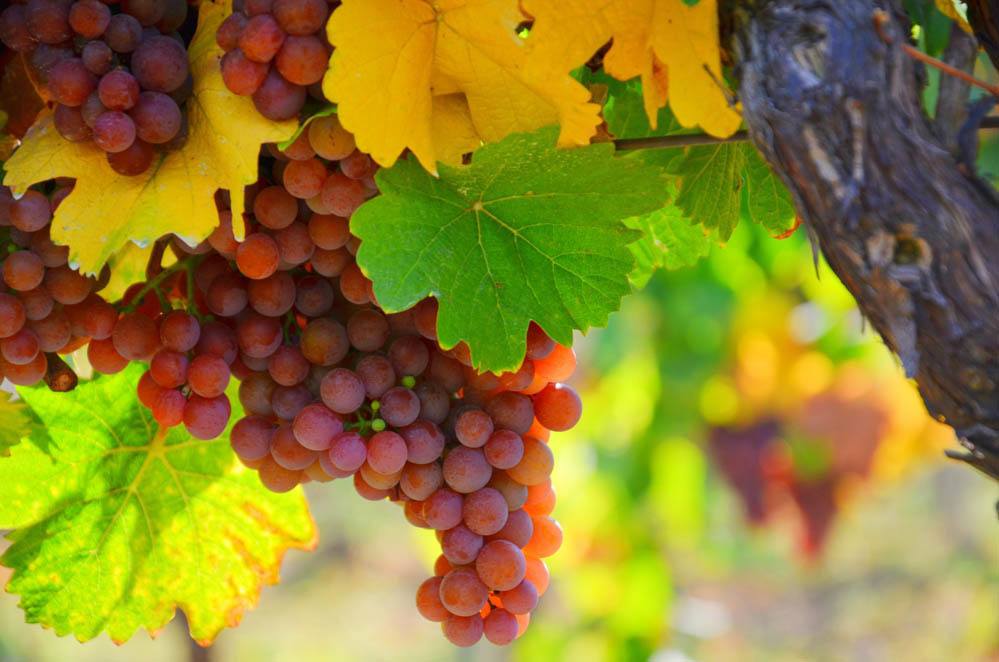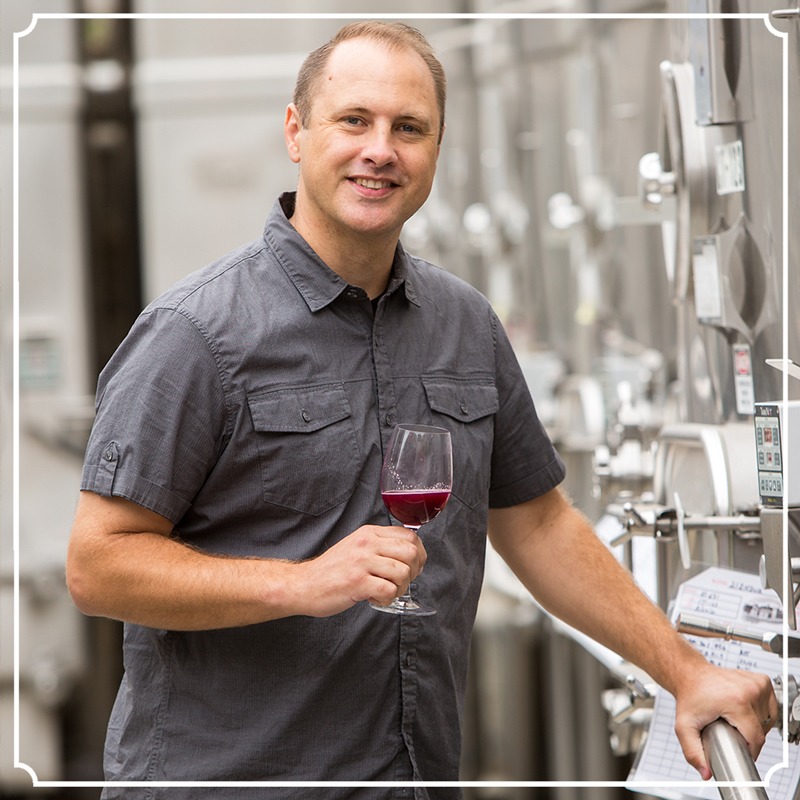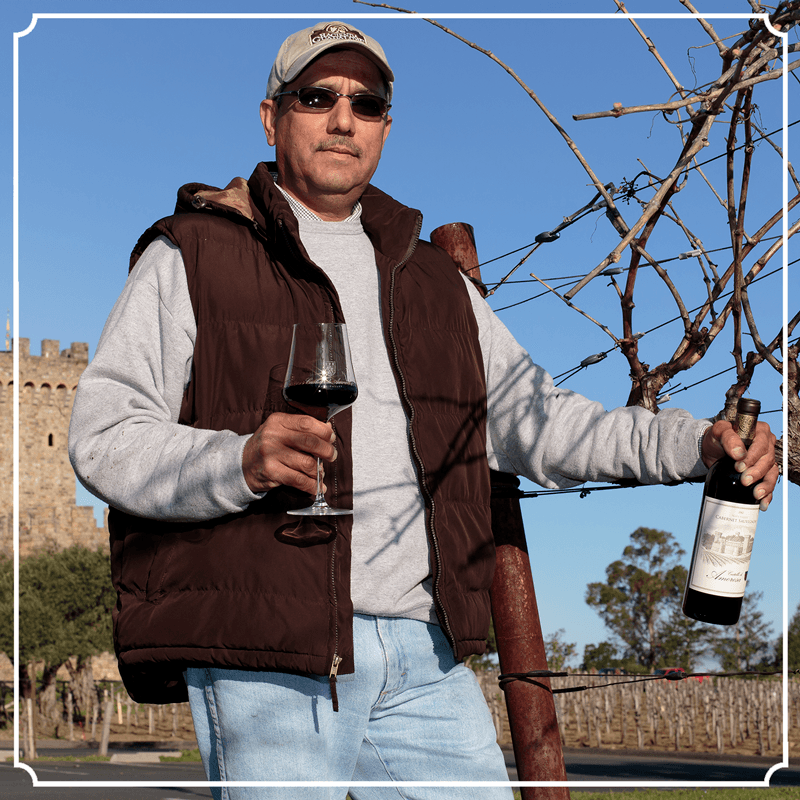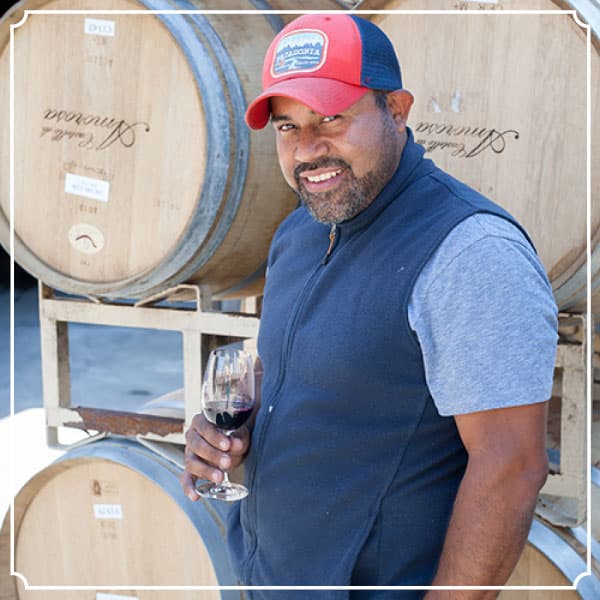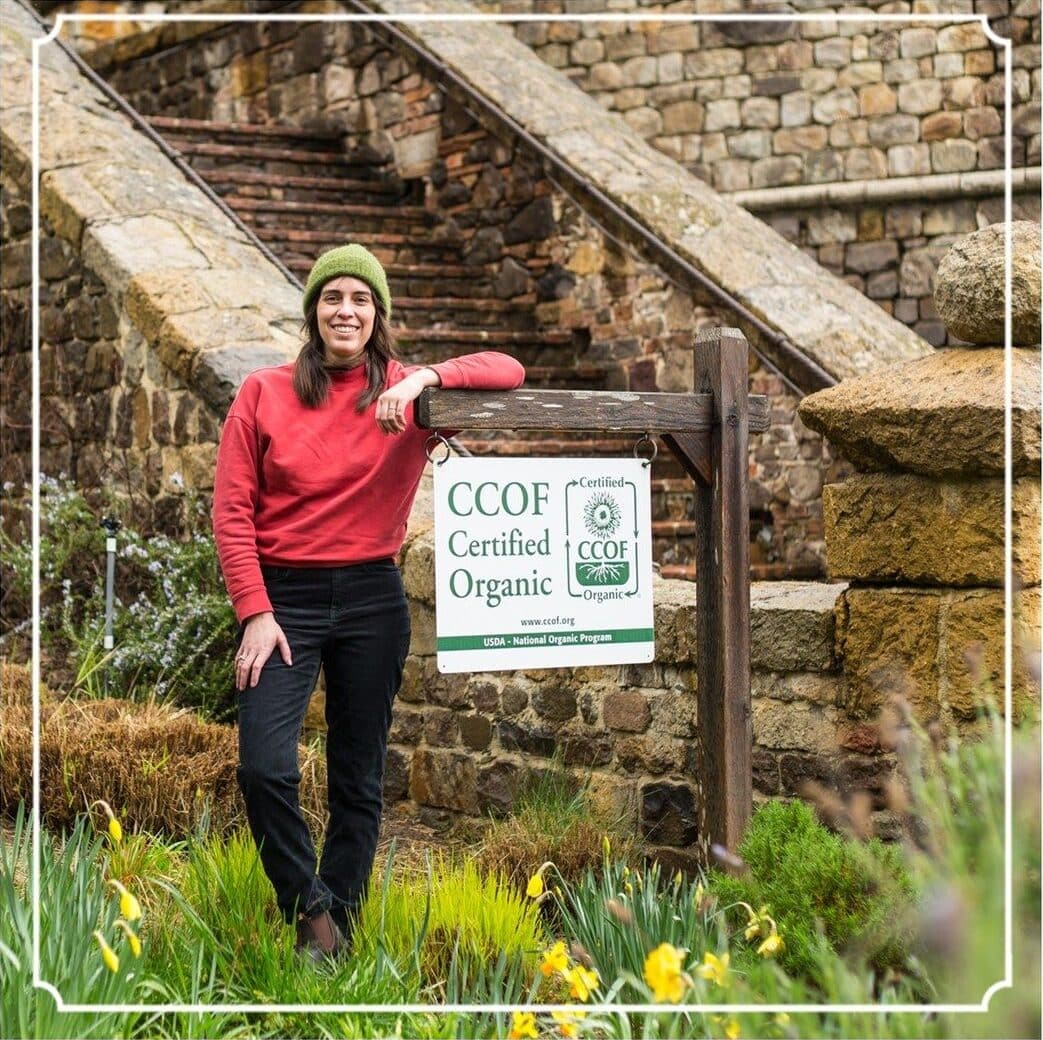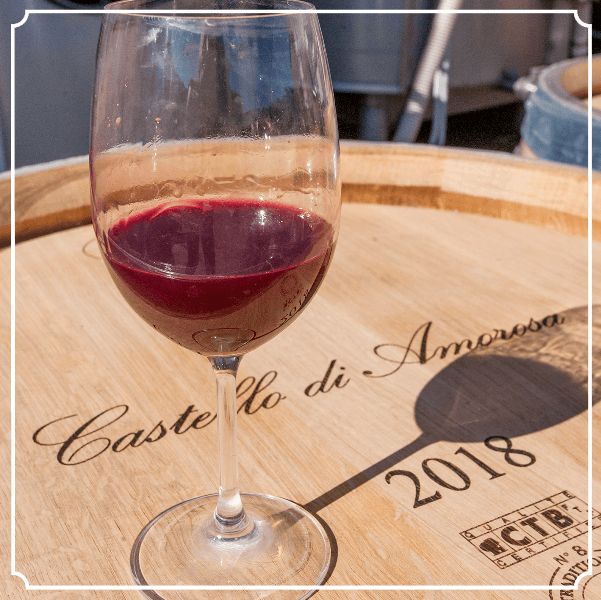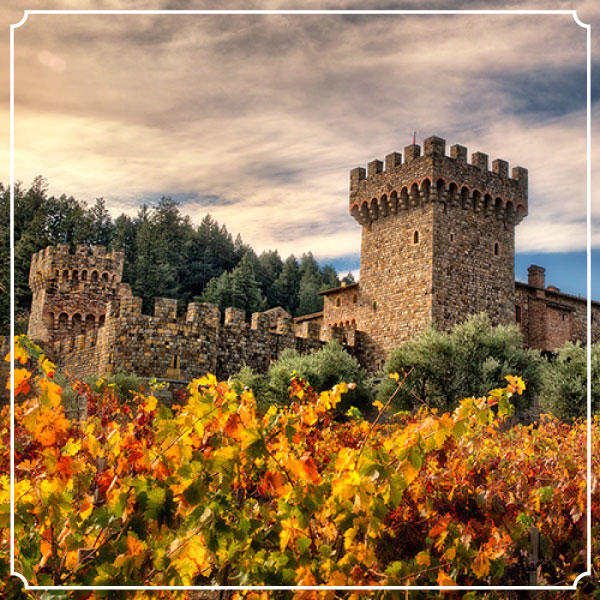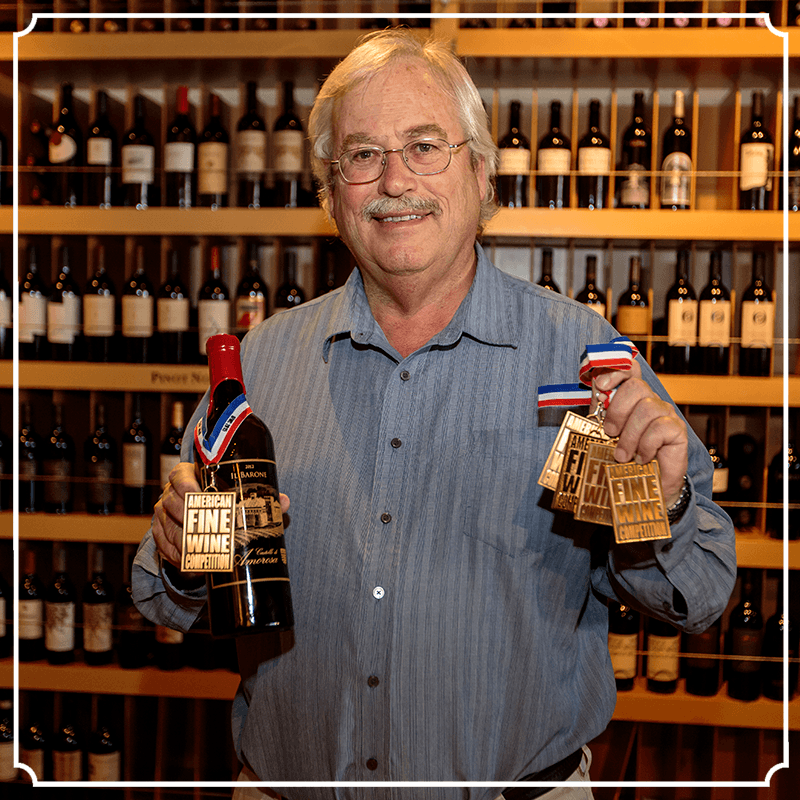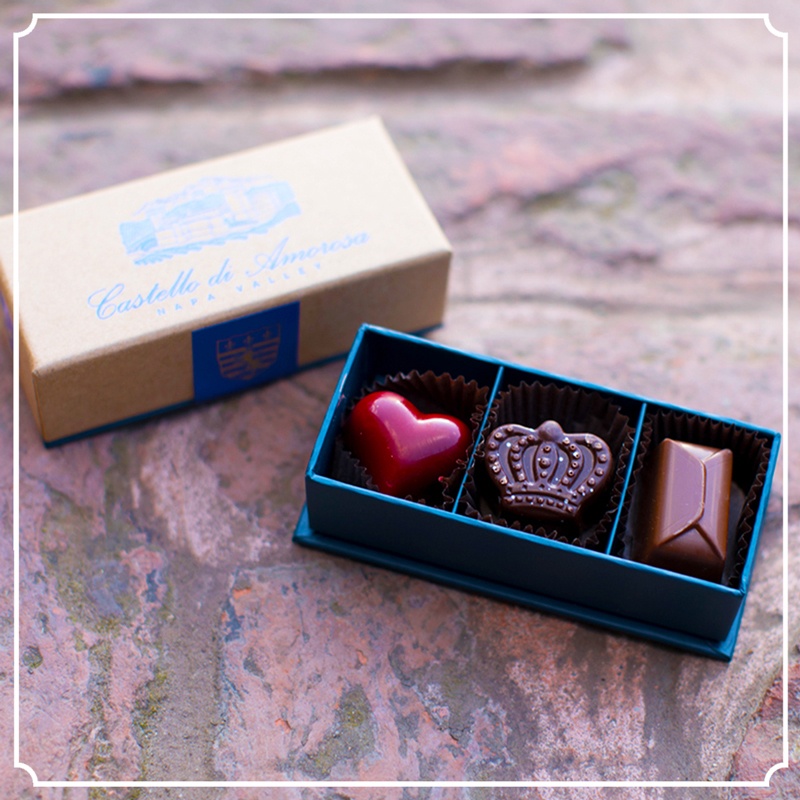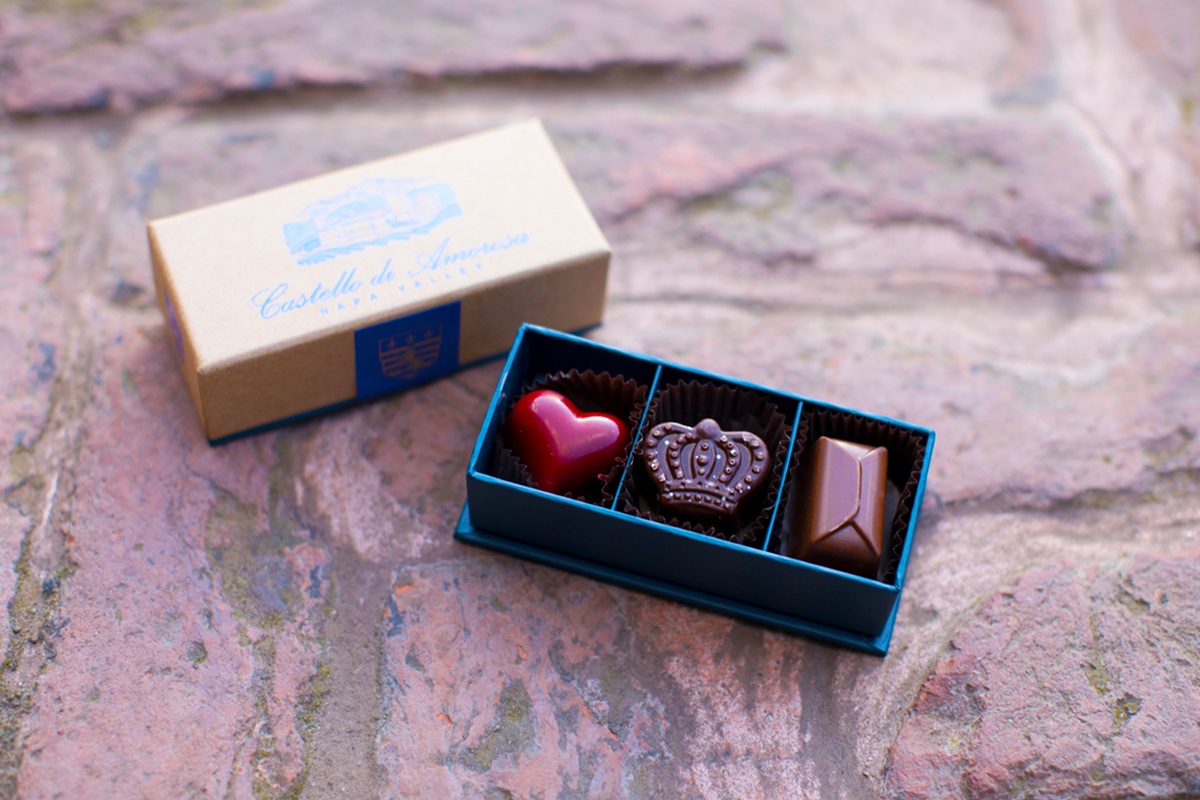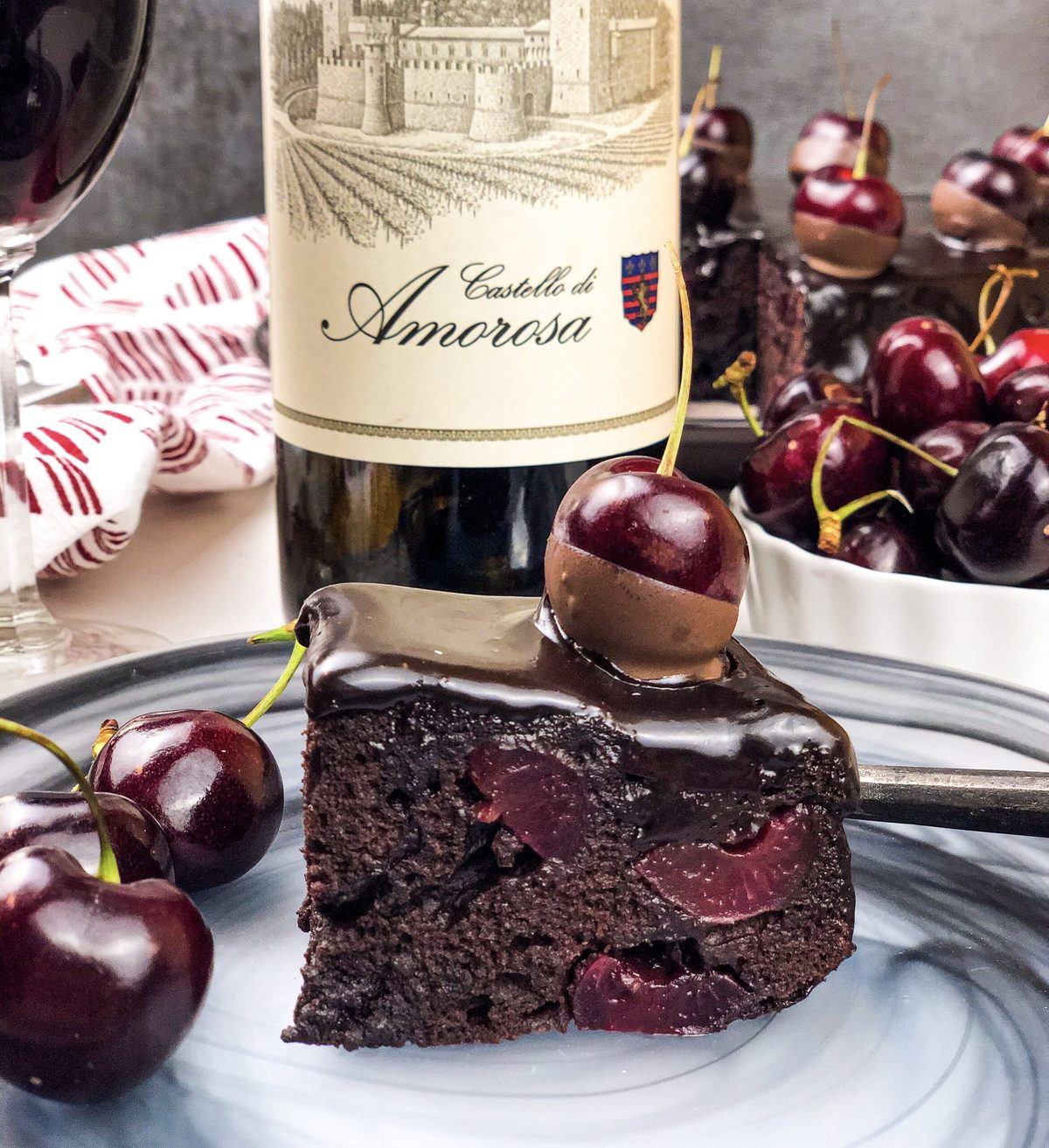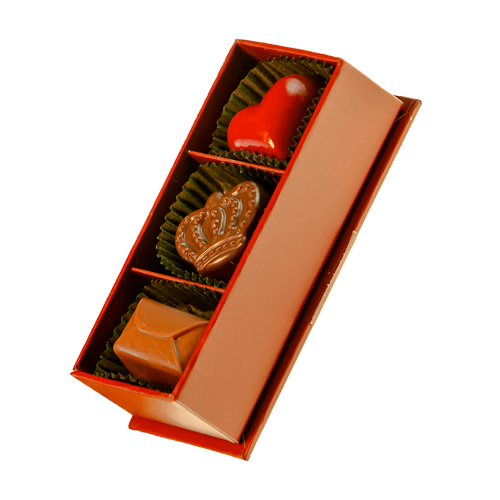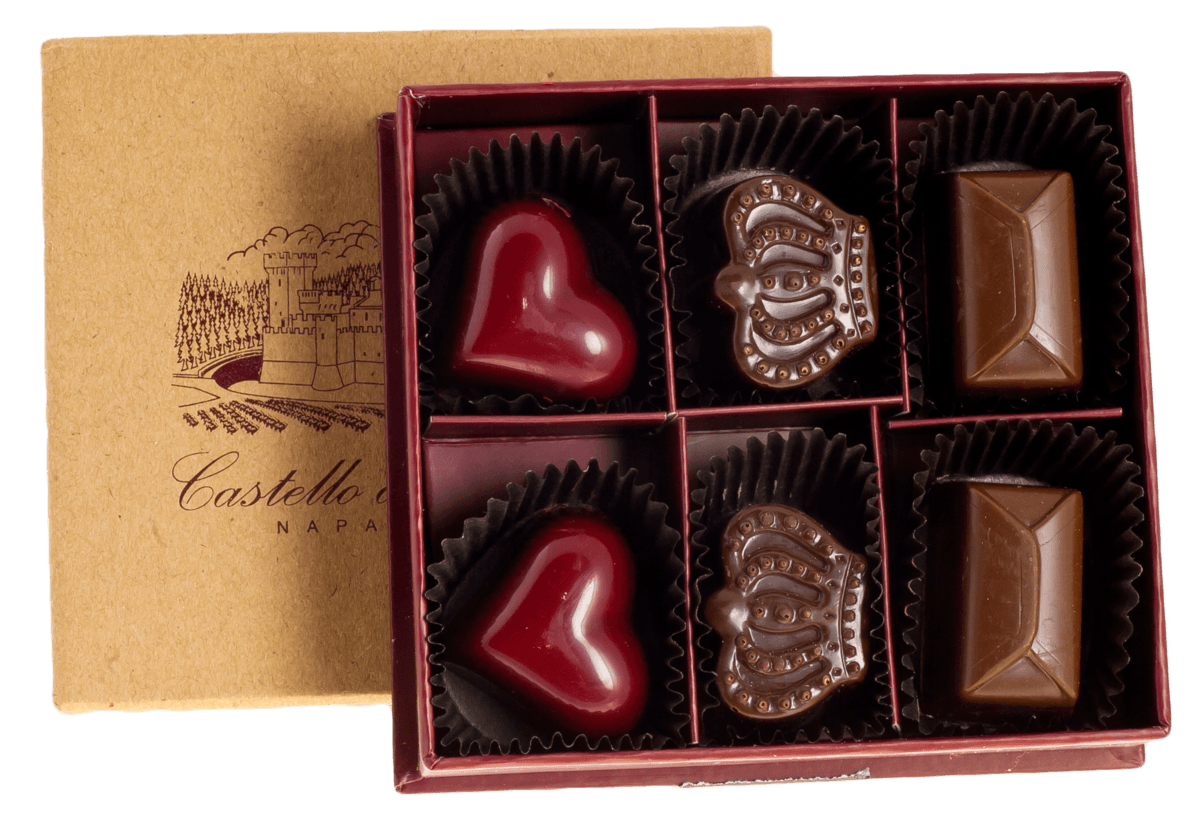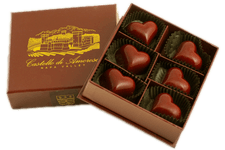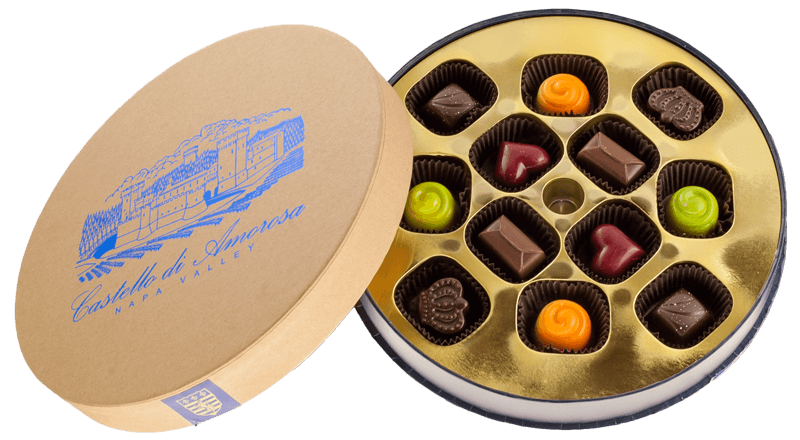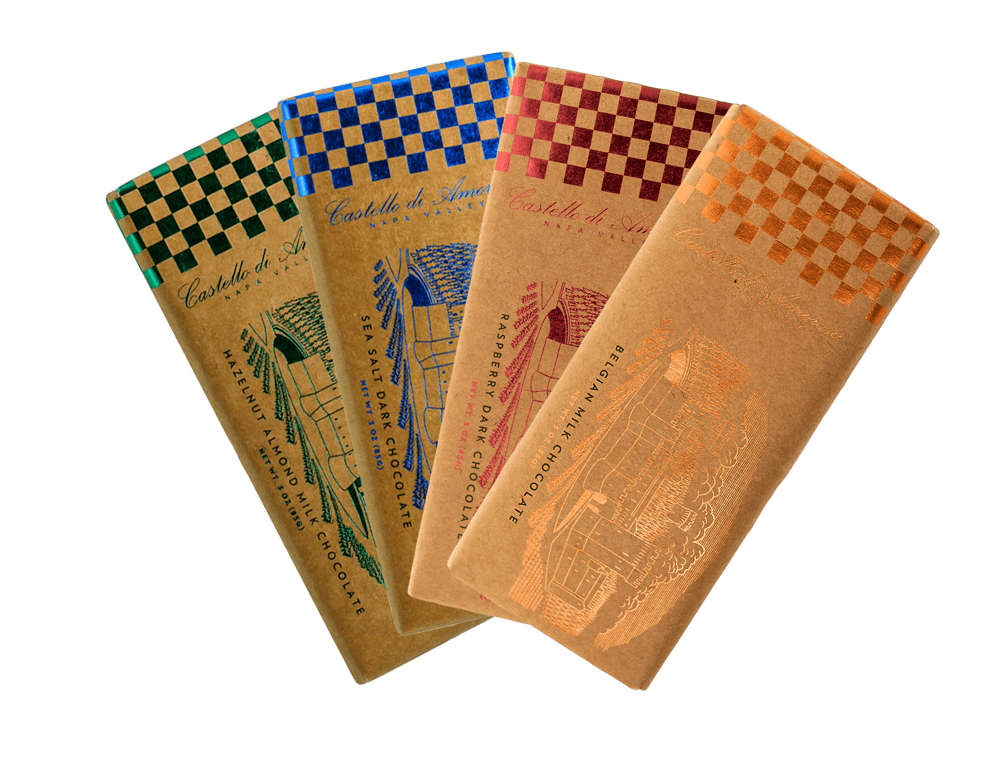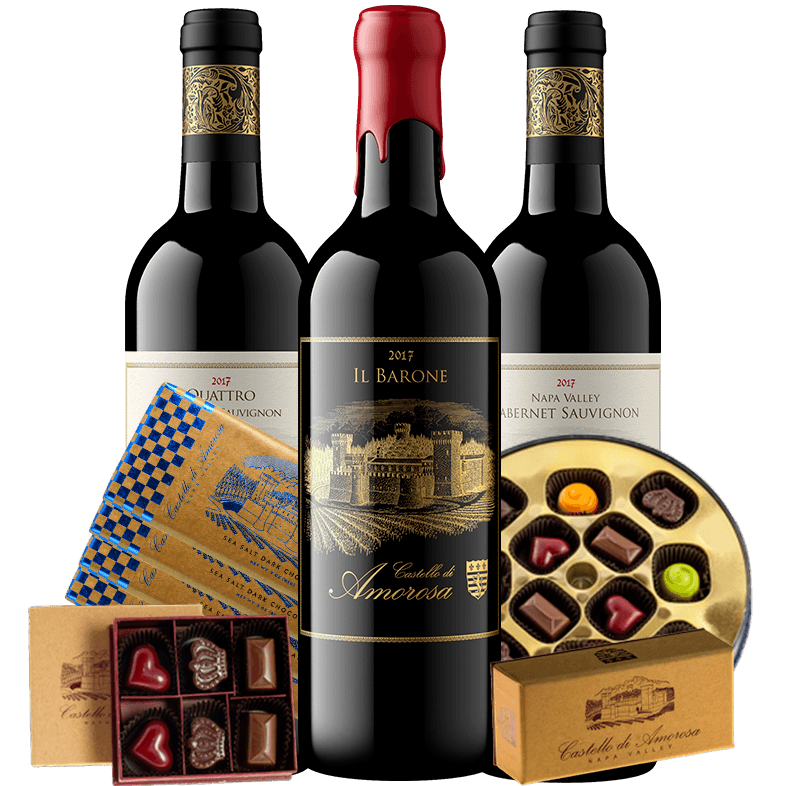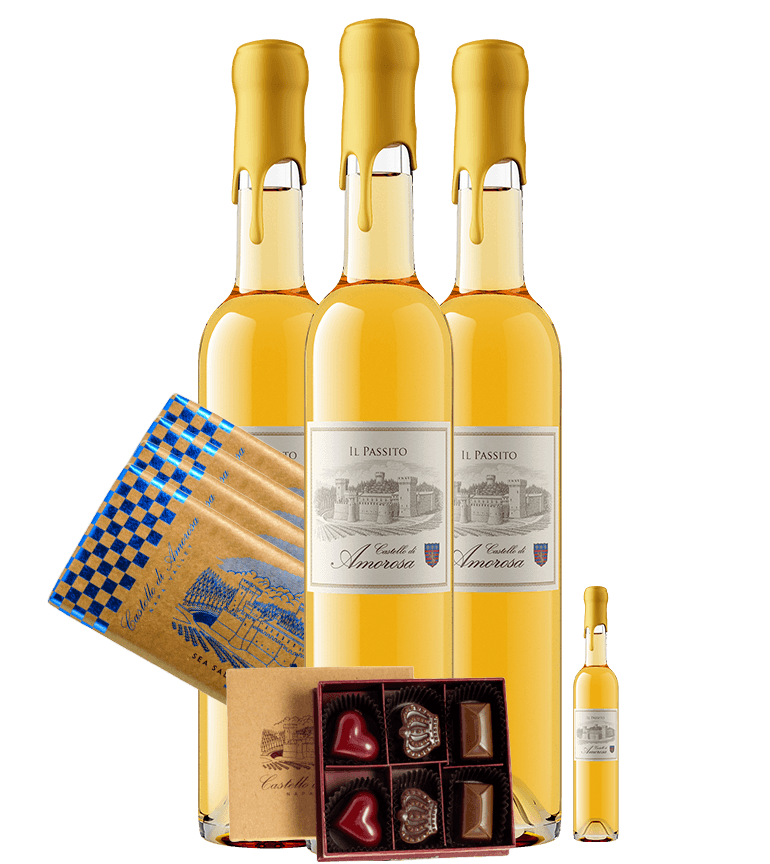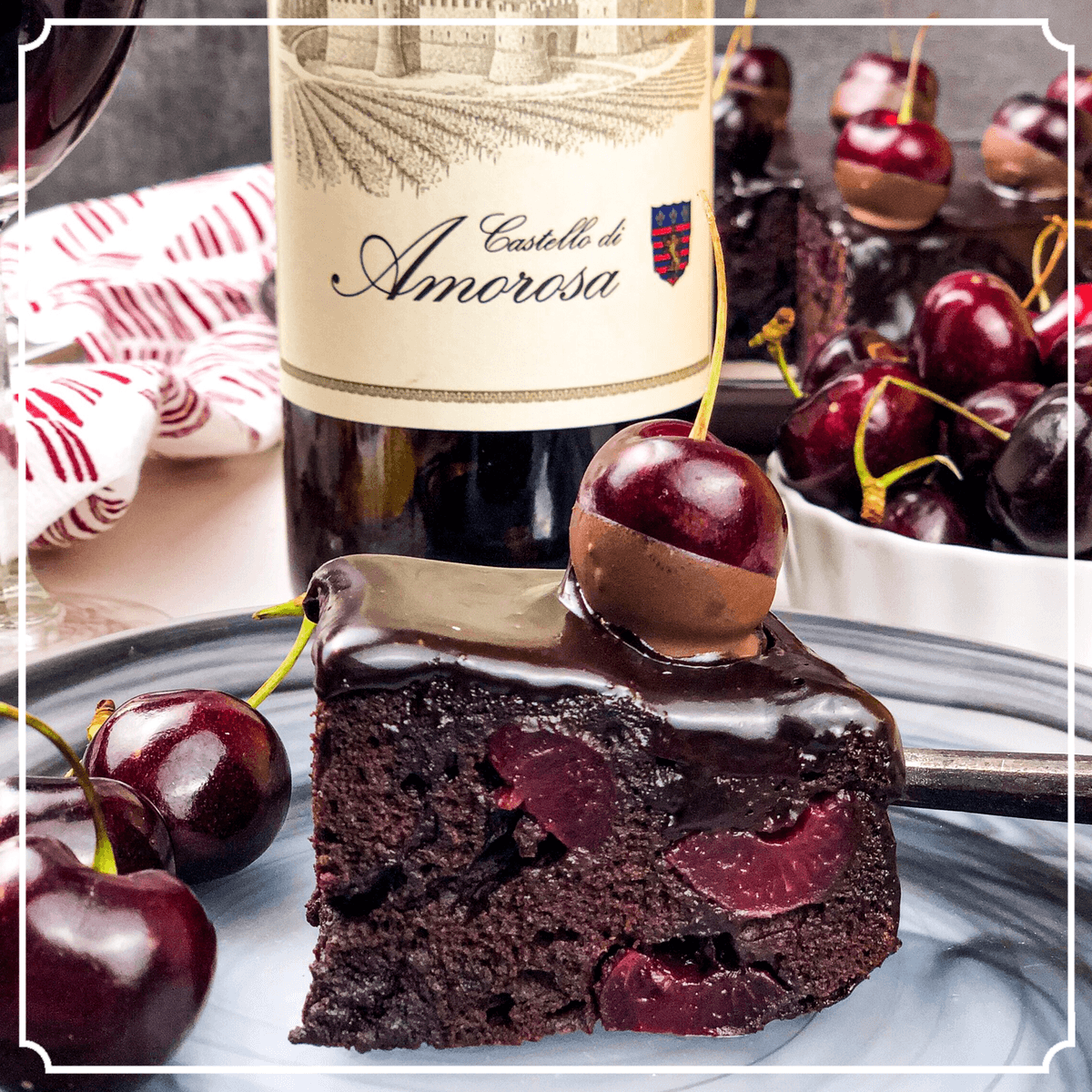Planting Olive Trees

Bradley Aden
Our First Olive Oil Trees
We are proud to announce the first planting of our Olive Trees surrounding the Castle in Napa Valley. Watch above as President Georg Salzner & vineyard manager David Bejar plant our first olive trees at The Castle! This continues our recent string of sustainability efforts at the Castle.
We planted 12 different varieties of Olive Trees surrounding Castello di Amorosa, these olive trees are known to make a superior olive for oil production. Many of these trees originate in Italy. We look forward to the first fully mature harvest in which we can produce our first olive oil.
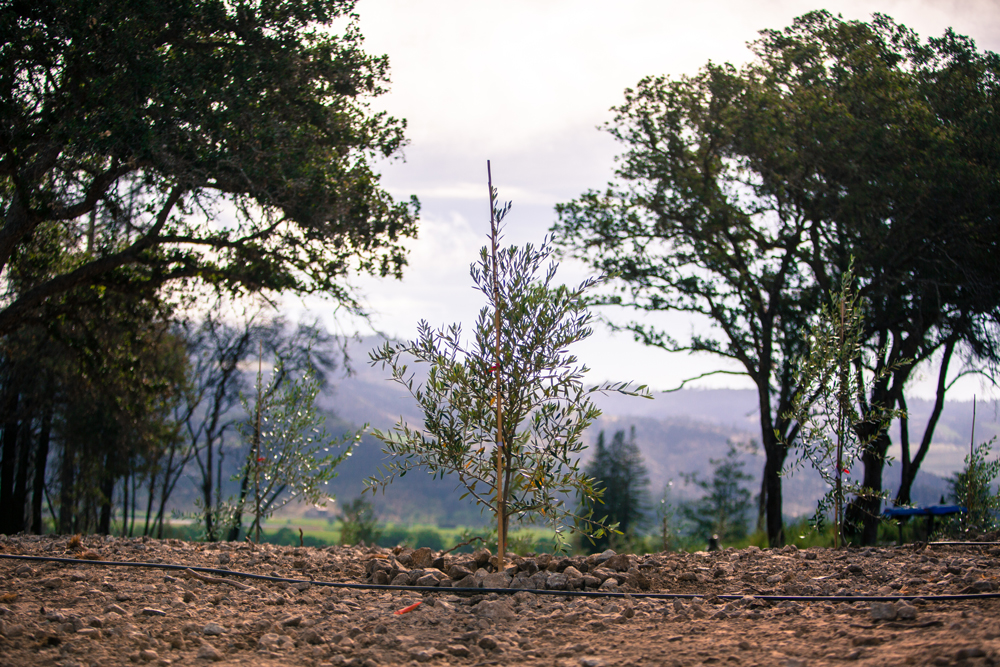
We are planting a total of 12 different olive tree varietals that surround the Castle. You can learn more about each specific type of Olive tree below.
Frantoio
If asked to pick our favorite olive in the bunch, that answer might just be the Frantoio olive. Frantoio Olive Oil is one of the most highly acclaimed oil varieties in the world, especially in the Tuscan regions of Italy. The olive boasts a stunningly dark, oval-shaped olive. Preferred picking time is early, while olives are still green and purple.
The flavor has been described as very fruity, notably aromatic and of high quality, with a stronger aftertaste than Leccino. The aftertaste has been described of almond and herbs.
This fast-growing Olive tree is known for its high yielding nature. They can reach a full grown height of 26 feet. It is known to produce plenty of plump medium-sized Olives, which are known to produce quality oil. They can also make a delicious treat when cured. These Olives are about 80% pulp, and they have a pleasant fragrance.
Olive Origin: Tuscany, Italy
Olive Color: Green-Purple, Purple-Black
Olive Pairing: Grilled Meat, Bruschetta, Legume & Vegetable Soups, Dressing Fresh Salads.
Olive Flavors: Fruity flavor with bitter and spicy notes. Aromas of fresh herb, tomato, lettuce, artichoke, apple, grain, rosemary, celery and almond.
Unique Traits of the Frantoio Olive
Most commonly the main component for a Tuscan style oil.
Consistently produces a high-yield, very fruity oil.
The medium size fruit ripens on the late side.
A self-compatible tree, but will benefit greatly from other pollinators.
One of the most popular olives in the world.
Grows More like Tree Than Bush
Leccino
Originated in Tuscany, grows very well in California and the northwest. Its olive oil flavor is delicate so it’s most commonly blended with Pendolino. But it’s also interplanted and blended with Frantoio, Coratina and Moraiolo to produce more flavor.
As mentioned above, Frantoio and Leccino cultivars are the principal raw material for Italian olive oils from Tuscany. Leccino has a very sweet and aromatic flavor.
A Small fruit with very small pit, it has a surprising amount of flesh. The fruit is purple-black, although it is advised to pick it when purple green at its optimal time. Oil volume is lower than other cultivars and delicate in flavor. The oil is mildly fruity and frequently blended with other cultivars’ oil. The delicate flavor can dissipate after time, as the oil has been known to have a short shelf life.
Olive Origin: Tuscany, Italy
Olive Color: Grey-Green
Olive Pairing: Cooked Fish, White Meats, Vegetables & Fresh Cheeses
Olive Flavors: The oil is very sweet and aromatic
Unique Traits of The Leccino Olive
Most commonly the main component for a Tuscan style oil.
Small Fruit
Short Shelf Life
Delicate Flavor
Commonly Used in Blends
Pendolino
Pendolino Olive Tree is an old Italian variety valued for its high fruit production as well as its crucial role as one of the best pollenizers for other olive varieties, often referred to as the universal pollenizers.
These slow growing trees can grow to about 20 feet tall in time. Pendolino is named for its pendulous branching characteristic, making it ideal for manual cultivation.
Its fruit size is generally larger than Frantoio but smaller than Leccino. It has a slightly lower oil content with relatively early ripening fruit. The flavors have been described as fruity and sweet upon entrance, while turning bitter and ending with a characteristic spicy. Notes of bitter almond and more lightly fresh grass and artichoke have been described.
Olive Origin: Italy
Olive Color: Grey-Green
Olive Pairing: Grilled Salmon, Risotto with Shrimp, Pasta, Bread, Vinaigrettes
Olive Flavors: Fruity and Sweet upon entrance, Bitter and Ending with a Spicy Kick. Notes of Bitter Almond, Grass & Aartichoke.
Unique Traits of The Pendolino Olive
The Universal Pollenizers
Early Ripening
Old Italian Varietal
High Production
Balanced Flavors
Maurino
The Maurino olive tree is Tuscan in origin. It’s a good pollinator but self-sterile so it needs another tree (often Frantoio, Leccino or Pendolino). Its fruit is small, but like the Pendolino cultivar, its fruit is abundant. Additionally, both cultivars actually look very similar in appearance and exhibit the graceful, pendulous branch form.
Prized for its sweet and delicate oil, as well as being tolerant of very low temperatures, it’s ideal for cooler climates and dense plantings. Small fruit with very small pit., It has a surprising amount of flesh. The oil is very sweet and aromatic. The shelf life is short.
Olive Origin: Tuscany, Italy
Olive Color: Grey-Green
Olive Pairing: Green Salads, Raw Vegetables,
Olive Flavors: The Oil Sweet and Aromatic
Unique Traits of The Maurino Olive
Tuscan Origin
Good Pollinator
Needs to Be Paired with other trees to survive. (often Frantoio, Leccino or Pendolino)
Small Fruit
Sweet & Delicate Oil
Short Shelf Life
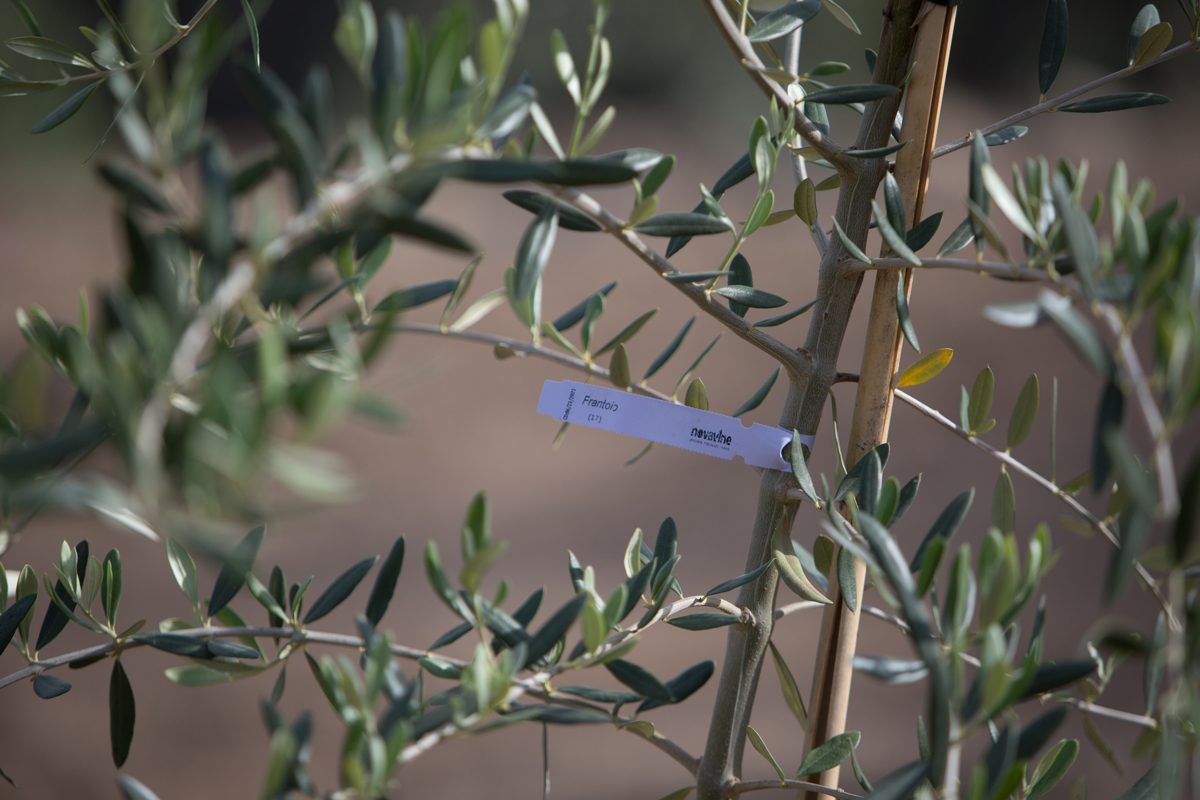
Mission
The Mission Olive Tree originated in California way back in 1769, where they were planted by Franciscan priests as they established Missions among El Camino Real. Popularity grew due to its growth in California over the years when interest in olives and olive oil increased. The Mission Olive Tree can grow up to 30 feet, with its olives maturing October through November.
The only American olive cultivar listed by the International Olive Council in its World Catalogue of Olive Varieties. After the Manzanilla and Sevillana olive varieties, it remains one of the more common cultivars in the state.
These medium olives can grow up to an inch-and-a-half and turn deep eggplant purple when mature. While the dark fruit is popular, the Mission is also harvested for it green fruit which is known for its wonderful, mild grassy flavor both in cured table olives and pressed to oil. Mission olives have a unique fruity flavor and scent. The fruit and oil pairs well with fish, chicken, or as a dip for freshly baked bread.
Olive Origin: California 1769
Olive Color: Deep Eggplant Purple – Blackish
Olive Pairing: Best Used with Bread, Fish or Chicken
Olive Flavors: Mild Grassy & Fruity Flavor
Unique Traits of The Mission Olive Oil
Endangered Varietal
Wonderful Fruit to Brine or Press for Oil
One of the Hardiest Olive Varieties
Attractive Specimen
Drought Tolerant
Widely Adaptable
Fragrant Spring Flowers
Mid Season Fruiting Time
Versatile Used for Olive Oil & Table Olives
Manzanilla
The Manzanilla is an ancient olive tree that have been grown since ancient times, they are known to thrive in the heat. Believed to be a native of the Mediterranean, the drought tolerant Manzanillo Olive can live for hundreds of years, enduring droughts, heat and poor soil conditions. Manzanilla olives are well known for its rich black olives that can be pickled or pressed for oil. They are known to have crisp texture and a slightly smoky, almond like flavor.
This Manzanillo has a slow growth rate and young trees may take time to develop substance. The tight growth pattern creates a fuller crown, making the Manzanillo Olive a popular shade tree in Southern California. It can grow up to 30 feet, so it is an ideal choice for almost any style architecture.
Easy to care for and very resilient, the evergreen Manzanillo Olive prefers deep rich soil, but it can tolerate stony, shallow soils as well.
Olive Origin: Mediterranean
Olive Color: Black – Green
Olive Pairing: Pair them with: Swiss, Manchego, or Gouda cheese; dry Spanish Cava or Fino. Olives themselves are often Suffed with a Creamy Blue Cheese, Pimentos, or Garlic.
Olive Flavors: Crisp Texture and a Slightly Smoky, Almond like Flavor.
Unique Traits of The Manzanilla Olive
Cold Hardy and Resistant to High Summer Heat
Drought Resistant
Versatile
Used for Table Fruit
Excellent Quality Fruit
Versatile Landscape Tree
Itrana
Native to the Italian region of Lazio (Lazio). The Itrana olive tree produces high quality black table olives and high quality extra virgin olive oil.
The oil is known for its intense and fruity flavor, with bitter and spicy feel. Aromas of cut grass are common with more subtle touches of artichoke or slight green almond feel.
The olives themselves are, asymmetrical and of medium size (3-5 grams). At harvest the olives are dark wine color, freckled with a whitish dusting. The oil is of good quality pleasing in taste and is noted for continually winning awards for taste.
Olive Origin: Lazio, Italy
Olive Color: Dark Wine Color & Green
Olive Pairing: Crusty Artisan Breads
Olive Flavors: Intense and Fruity Flavor, with Bitter & Spicy of Average Value. Aromas of Cut Grass are Common with Subtle Touches of Artichoke or Slight Green Almond Feel.
Unique Traits of the Itrana Olive
Resistant To High Heat & Cold
Italian Varietal
Green & Dark Producing Olives
Award Winning Oil Produced
Excellent Quality Fruit
Coratina
Coratina olive oil gets its name from its place of origin, a town in the Italian countryside known as Corato. This olive oil has a very fruity, tangy and bitter taste, so much so that traditionally this particular kind of olive oil has been used to cut other olive oils with a less marked flavor.
Depending on the climate, olive picking may go from early October to late January. The integrity of the fruit will determine a low acidity level, fruity notes and a high content of antioxidants in the final product.
The Coratina extra-virgin olive oil is characterized by the fruity notes of green olives, followed by sensations of freshly-cut grass and bitter almonds. By genetic makeup, Coratina is one of the olive cultivars that synthesize the highest content of phenolic compounds. Freshly-pressed, the Coratina olive oil may taste bitter and unbalanced, with a bit of a slightly sharp sensation. The high phenolic content, along with the triglyceride composition, contributes to the exceptional oxidation stability of the Coratina extra-virgin olive oil.
Olive Origin: Corato, Italy
Olive Color: Dark Red – Light Green
Olive Pairing: Used to Cut other Olive Oils with a Less Marked Flavor.
Olive Flavors: Fruity, Tangy and Bitter Taste
Unique Traits of the Coratina Olive
High Phenolic Acid Content, produces Incredibly Stable Oil that Oxidizes Slowly.
High Acidity Results in Sharp Oil that is Rich in Flavor and Displays a Sweet Aroma.
Can Produce in a Variety of Climates and Soil Conditions from Sandy Coastal Locations to Hot Deserts with Rocky Soils.
Minimal Watering Once Established.
Smaller Fruits
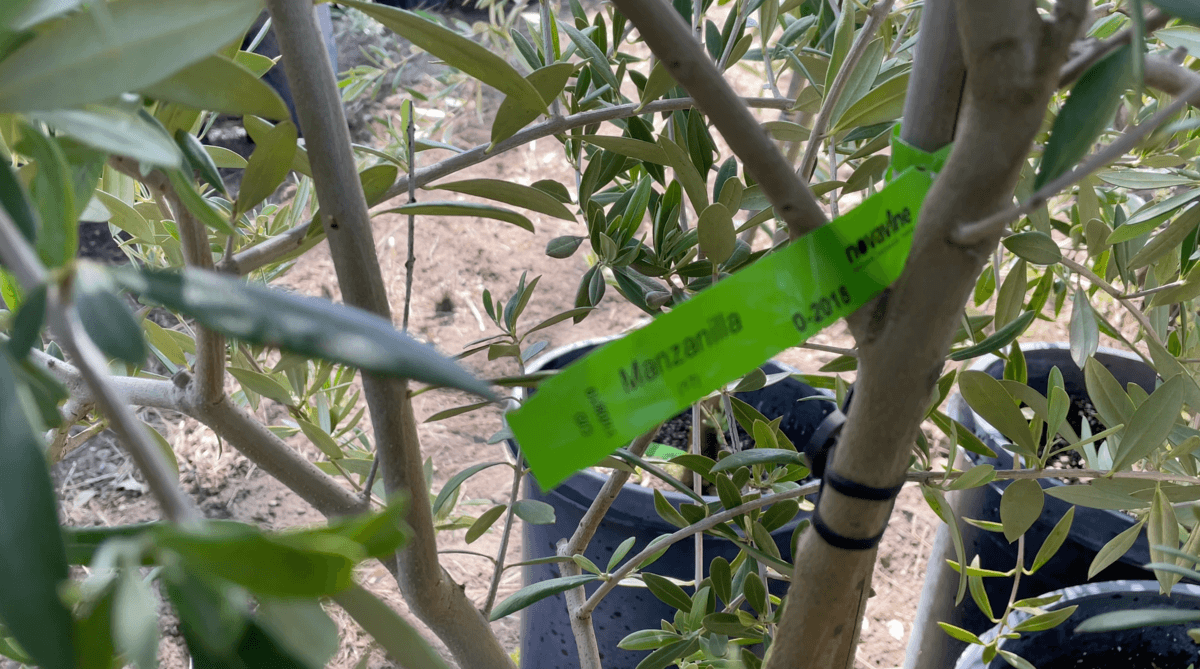
Columella
Originating in France, Columella is known for its resistance to cold. When harvested green, Columella yields an aromatic, sweet and fruity oil with a good balance of bitter and pungent notes. Grassy and herbaceous flavors are enhanced by tropical and floral flavors.
Fruit ripening is medium early. Columella is unusual among the French cultivars normally grown in California in its suitability for early harvest. The fruit is fragile and prone to bruising; it can be damaged by windy storms as it is ripening, so an early harvest is advisable.
Olive Origin: France
Olive Color: Green
Olive Pairing: Fried Potatoes, Stir-Fry, Chocolate Ice Cream
Olive Flavors: Aromatic, Fruity, and Sweet Flavor, Balanced with Pungent and Bitter Flavors too.
Unique Traits of the Columella Olive
Adapts Well to Colder Weather
Versatile Smooth Taste
Fruit Can be Easily Damaged
Fruit is Fragile, Prone to Bruising
Cerignola
Cerignola olive tree (Oliva di Cerignola), is an Italian olive variety present in the Apulia region. Its origin is estimated in the XV century, when it was introduced by the Aragonese. The olive tree produces very large size olives, which are popular table olives.
Cerignola may offer the most beautiful and delicious olives of any tree. It ripens early and is generally brined soon after turning a celadon green. Drupes are large, nearly a half ounce of crisp, buttery meat.
The flavor of the Cerignola olive has been described as mildly tart and buttery. It is known for containing very balanced flavors, thus making it one of the most versatile olives.
Olive Origin: Apulia Region, Cerignola, Italy
Olive Color: Celadon Green
Olive Pairing: Pair up these buttery beauties with zippy hard cheeses, like Parmigiano-Reggiano, or mild and creamy mozzarella and Genoa Salami. Black varieties are great paired with smoked cheeses.
Olive Flavors: Mildly Tart and Buttery.
Unique Traits of The Cerignola Olive
Estimated Origins Go Back to The 15th Century.
Large Size Olives
Ripens Early
Versatile Olive Used for Both Oil Production or Table Olives
Balanced Flavors
Lucca
The Lucca Olive Tree is a high yielding tree, which is used for high amounts of olive oil. The Lucca Olive itself was developed at the University of California, Davis by Professor Hartman. These trees will grow beautifully in your yard, and will produce large quantities of olives.
It also has good frost resistance and is closely related to Frantoio olive. A vigorous variety well suited to planting in California. The oil produced from the Lucca has been described by tasters as having a sweet buttery flavor, and slightly bitter.
Olive Origin: California
Olive Color: Green
Olive Pairing: Used to cut other olive oils with a less marked flavor.
Olive Flavors: sweet buttery flavor, and slightly bitter.
Unique Traits of The Lucca Olive
Sweet, Buttery Flavor
Developed closely related to Frantic.
Developed by University Professor
High Yields
Hojiblanca
The name means “white leaf” and refers to the color of the back side of the leaves. This medium sized fruit generally ripens late and is very cold resistant. These trees are capable of adapting to extreme soils and climates. The fruits ripen very slowly and delay the harvest, a fact that leads to certain amount of “vecería”.
A balanced olive that has a wide range of flavors. The oil is not long lasting but is exceptional. The Hojiblanca olive is highly valued due to the excellent quality of its pulp and for its great rusticity.
The Hojiblanca is a prestigious varietal, currently in great demand especially in Spain due to the Hojiblanca extra virgin oil which can be extracted from its fruit, it is also widely used as a table olive.
On many occasions, the extracted oil is combined with other oils in order to improve the flavor and the oils properties. This oil is recommended by many specialists due to its excellent health reputation.
Olive Origin: Spain
Olive Color: Green
Olive Pairing: Red Apple Balsamic Vinegar, Sicilian Lemon White Balsamic Vinegar, Leafy Green Salads, Bitter Green Salads, Garden Salads, Raw Vegetables., Roasted/Grilled Veg, Broiled Fish.
Olive Flavors: Slightly sweet to start with a bitter taste of unripe fruits and an almond aftertaste
Unique Traits of The Hojiblanca Olive
Known for its health benefits
Great Demand
Versatile Olive Used for Both Oil Production or Table Olives
Late Ripening
Excellent Quality
Balanced Taste
Large Fruit
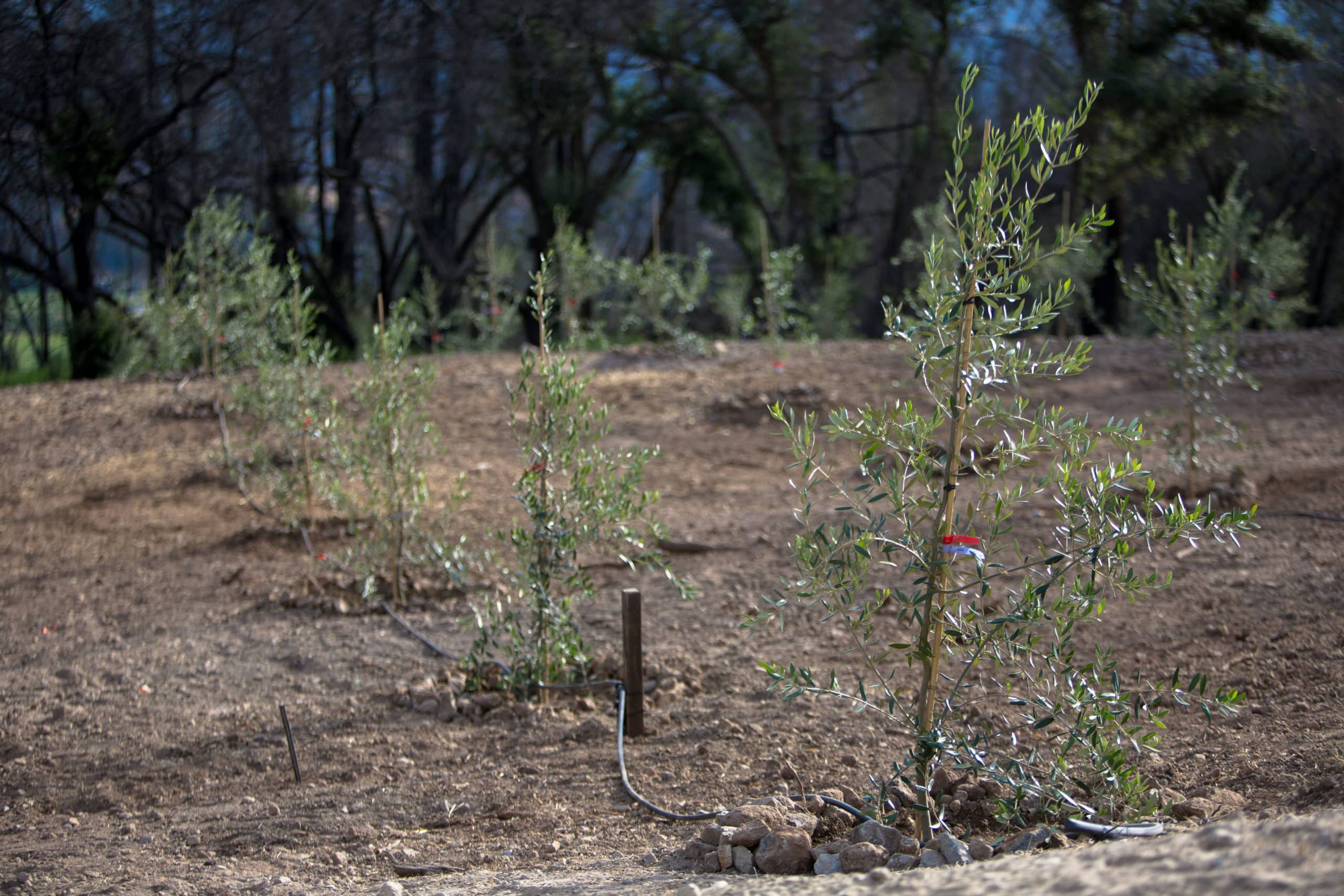
Although these trees won’t be producing olives worthy of pressing into olive oil for at least five years, we do make Olive Oil exclusively from olives harvested at our own Morning Dew Ranch estate property in the Anderson Valley located in Mendocino County.
These mature olive trees grow on a small patch of sloped hillside adjacent to some of the Castello’s most prized Pinot Noir vines. These trees mature under the watchful eyes of both our Winemaker and Vineyard Manager.
This Morning Dew Ranch Olio Nuovo (which means, new oil) differs from your typical Olive Oil. Taken straight from the press, this freshly pressed oil has all the natural flavors left inside the oil. Cold Pressed under 50 degrees, harvested locally from the Castello’s own estate vineyard. Here at the Castle, we are one of the first in the Napa Valley to sell Olio Nuovo.
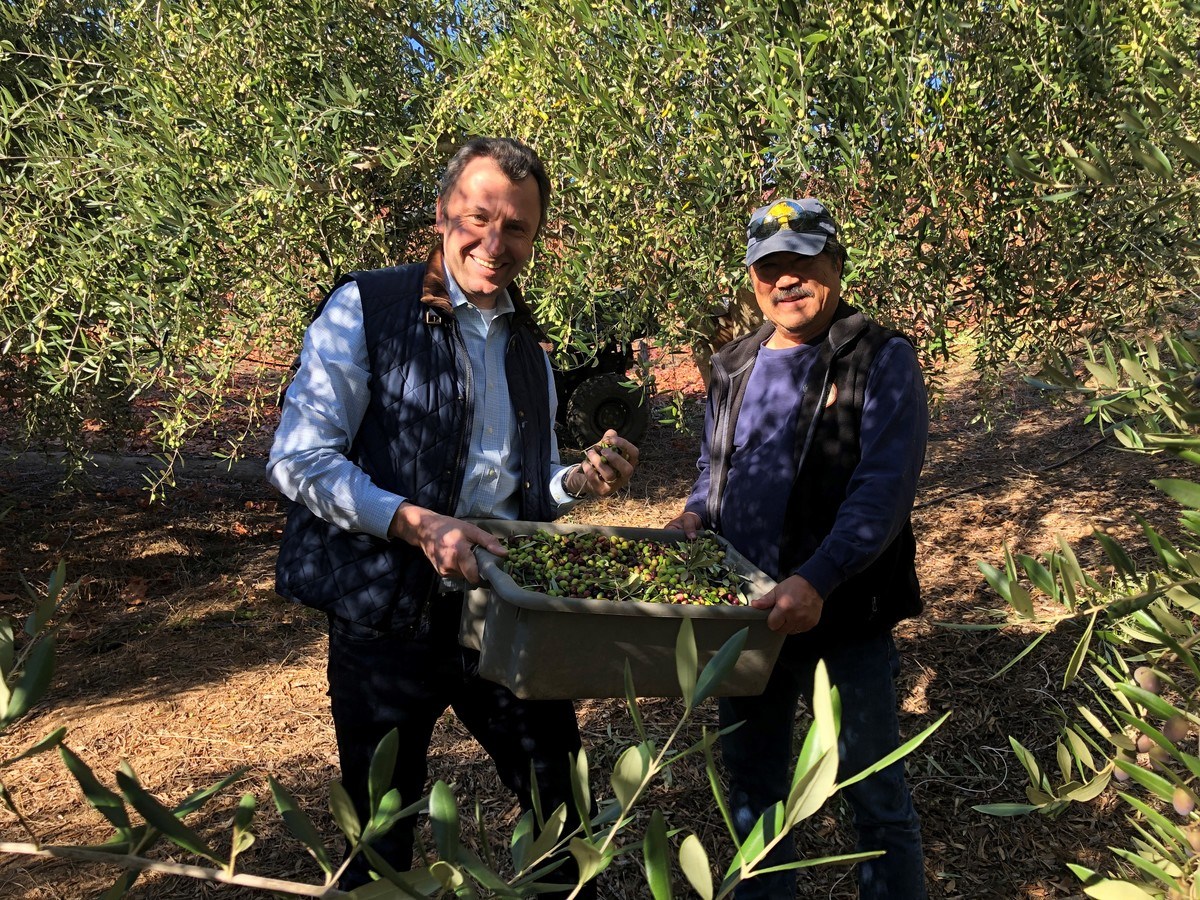
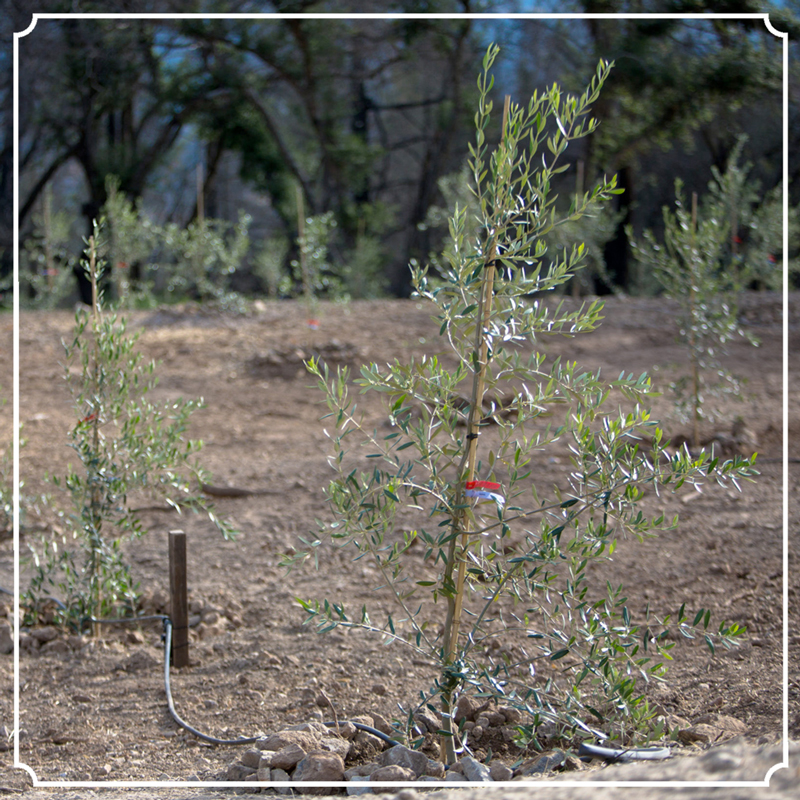
Rapp Ranch

Bradley Aden
Run Wild with Our Single Vineyard Cabernet
Rapp Ranch is our single vineyard Cabernet from the Coombsville AVA. The wine is inky purple in color, with an imposing structure that frames a mouthful of savory spices, blackberries, and wild herbs. The tannins are silky and smooth, leading to a remarkable impression of black fruits and lingering flavors on the palate. The wine is expected to age nicely and cellar from 15-25 years.
Located in the heart of the Coombsville AVA, Rapp Ranch has long been established as a premier horse ranch in the rural countryside of southern Napa Valley. The Coombsville AVA is one of the fastest growing Cabernet Sauvignon producers in Napa Valley. Having received its AVA designation in 2011, Coombsville is set to be Napa Valley’s next great Cabernet Sauvignon appellation. The defining characteristics of Coombsville, are the long, cool growing seasons that reward patient winemakers with intensely concentrated and complex wines.
Located just east of the city of Napa, the appellation varies from sea level all the way up to 1,900 feet on the Vaca Mountain Range. The cooling effects of the nearby San Pablo bay provide daily fog, which causes more constant temperatures. This allows us to have a long, slow ripening period as our vines bud early and our grapes are typically among the last to be harvested. Coombsville itself is a bowl-shaped depression, cradled by a crescent-shaped section of the Vacas Mountain Range.
Rapp Ranch in The Coombsville AVA
Long established as a premier horse ranch in the rural countryside of southern Napa Valley. The history of Rapp Ranch is rich in horses. Originally known as the premier breeding & training grounds for quarter horses in the Napa Valley, became world renown throughout the 1980s and 1990s. Utilizing a variety of barns, riding arenas and outdoor spaces, Rapp Ranch produced some of the top award winning international competitors. Continuing on to present day, the name Rapp Ranch has became synonymous with outstanding quality.
The property eventually sold to a businessman who removed some of the horse facilities and planted 12 of the 25 acres of ultra premium Cabernet Sauvignon grapes. When the opportunity presented itself, the Alkossers purchased the property in February 2016. Thoroughly enchanted by the beauty and significance of this place, they saw the potential in combining the history of the horse ranch, the premium vineyards and the state-of- the-art winery into the ultimate destination for wine connoisseurs and adventuring travelers.
When the opportunity presented itself, we were thrilled about partnering long-term with Rapp Ranch. Our winemakers Brooks Painter & Peter Velleno are proud to carry on the tradition of ultra premium Cabernet Sauvignon. We look forward to producing incredible vintages of Rapp Ranch Cabernet Sauvignon for years to come.
Past Awards & Accolades
Explore our past awards and accolades for our Rapp Ranch Cabernet Sauvignon.
CABERNET SAUVIGNON RAPP RANCH 2021:
- Lisa Perrotti-Brown, The Wine Independent (95 Points) – Deep garnet-purple in color, the 2021 Cabernet Sauvignon Rapp Ranch Vineyard needs a swirl or two to bring out fragrant notions of Morello cherries, black raspberries, blackcurrant pastilles, and licorice followed by hints of cedar and graphite. The full-bodied palate has a firm, grainy texture and a refreshing line to support the tightly wound black and red berry layers, finishing long and lifted.
- James Suckling (94 Points) – Aromas of blackcurrants and blueberries with hints of violets, cardamom, black tea and black olives. Beautiful texture with balance and freshness to the fruit. Polished and super-fine tannins with medium to full body and a long, even finish. Better after 2025.
- Jeb Dunnuck (95+) – The 2021 Cabernet Sauvignon Rapp Ranch Vineyard comes from a site in Coombsville and spent 20 months in barrel. It has a cooler, more lifted style in its red and blue fruits as well as sappy herbs, flowers, and sagebrush-like aromas and flavors. With medium to full body, ripe, present, fine-grained tannins, and a great finish, it’s another remarkably pure, impressive wine in the lineup that will keep for two decades or more.
CABERNET SAUVIGNON RAPP RANCH 2021:
- Lisa Perrotti-Brown, The Wine Independent (95 Points) – Deep garnet-purple in color, the 2021 Cabernet Sauvignon Rapp Ranch Vineyard needs a swirl or two to bring out fragrant notions of Morello cherries, black raspberries, blackcurrant pastilles, and licorice followed by hints of cedar and graphite. The full-bodied palate has a firm, grainy texture and a refreshing line to support the tightly wound black and red berry layers, finishing long and lifted.
- James Suckling (94 Points) – Aromas of blackcurrants and blueberries with hints of violets, cardamom, black tea and black olives. Beautiful texture with balance and freshness to the fruit. Polished and super-fine tannins with medium to full body and a long, even finish. Better after 2025.
- Jeb Dunnuck (95+) – The 2021 Cabernet Sauvignon Rapp Ranch Vineyard comes from a site in Coombsville and spent 20 months in barrel. It has a cooler, more lifted style in its red and blue fruits as well as sappy herbs, flowers, and sagebrush-like aromas and flavors. With medium to full body, ripe, present, fine-grained tannins, and a great finish, it’s another remarkably pure, impressive wine in the lineup that will keep for two decades or more.
CABERNET SAUVIGNON RAPP RANCH 2018:
- Lisa Perrotti-Brown (93 Points) – The 2018 Cabernet Sauvignon Rapp Ranch Vineyard is deep garnet-purple in color. Stewed plums, black cherry compote, and raspberry preserves notes spring from the glass, plus suggestions of coffee grounds, Sichuan pepper, and cassis. Medium to full-bodied, the palate offers a sturdy frame of chewy tannins and just enough freshness to support the muscular fruit, finishing earthy.
- Antonio Galloni, Vinous (94 Points) – The 2018 Cabernet Sauvignon Rapp Ranch is an opulent, heady wine. Dark cherry jam, bay leaf, cedar, tobacco and crushed flowers are all laced together. The Rapp Ranch is marked by a very pretty floral/savory quality that adds character. Drink it over the next 15 years or so.
- James Suckling (93 Points) – A fresh, juicy red with aromas of blackcurrant, chili jam, walnut and cocoa. It’s medium-bodied with succulent tannins. So drinkable. Drink or hold.
CABERNET SAUVIGNON RAPP RANCH 2017:
- James Suckling (93 Points) – Amorosa’s Rapp Ranch cabernet bottling has a very suave, cedary nose with regal, dark-berry aromas, typical of cabernet, as well as hints of fresh leather. The palate is so succulent and juicy with very fresh and attractively detailed tannins carrying good length. Fresh finish. Drink or hold.
- James Molesworth, Wine Spectator (92 Points) – Vivid plum, blueberry and açaí berry flavors stream through, flanked with graphite and inlaid with subtle alder and bay accents. Ripe and dense, but racy in feel, with a mineral thread at the very end that brings you back for more. Drink now through 2029. 185 cases made.
CABERNET SAUVIGNON RAPP RANCH 2016:
- Virginie Boone, Wine Enthusiast (90 Points) – A 100% varietal wine from one site, this red is earthy and wild, with thick, concentrated blackberry and rich vanilla. The tannins are intensely structured and powerfully smooth.
- James Suckling (95 Points) – A very deep and intense wine with a gorgeous core of ripe fruit and velvety tannins and a beautiful finish. Full-bodied and flavorful. Energetic finish. Reserved. Better in 2020.
- Lisa Perrotti-Brown, The Wine Advocate (93+)- Deep purple-black in color, the 2016 Cabernet Sauvignon Rapp Ranch displays subtle black raspberries, black and red cherries and black currants with hints of wild thyme, damp soil and tree bark. Medium to full-bodied, firmly textured with plenty of youthful, crunchy fruit, it has a pleasantly chewy finish.
- Wine Advocate (93+ Points) – Deep purple-black in color, the 2016 Cabernet Sauvignon Rapp Ranch displays subtle black raspberries, black and red cherries and black currants with hints of wild thyme, damp soil and tree bark. Medium to full-bodied, firmly textured and with plenty of youthful, crunchy fruit, it has a pleasantly chewy finish.
Disney's The Quest

Bradley Aden
Disney’s The Quest – Filmed on Location!
We are excited to announce the premiere of Disney’s The Quest on May 11th, the show features a competition series that was filmed here at Castello di Amorosa from December 2020 to March 2021. The Quest will premiere on their streaming service Disney+. This high paced show features a bevy of challenges, mazes and puzzles throughout the Castle. This will be the second season of The Quest.
Brought to the screen by the Academy Award- and Emmy-winning teams behind “The Amazing Race” and “The Lord of the Rings”. This ground-breaking, immersive, hybrid competition series drops eight real-life teenagers into the fantastic, fictional world of Everealm, where they must save a Kingdom by fulfilling an ancient prophecy. Everealm has long been a land of unrivaled beauty and powerful magic. Now, the realm is threatened by a powerful evil Sorceress. These eight teenage strangers known as the Paladins, must face a series of challenges in order to restore balance to Everealm. Throughout the eight-episode series, these heroes are immersed in a fantasy world come to life complete with a castle, royals, ethereal Fates, all forms of mystical creatures and a Sorceress intent on destruction and power.
Producer Rob Eric, said, “The Quest is a truly unique unscripted show as it takes contestants into a fully immersive world of magic and fantasy. There is no better partner than Disney+ for this type of enchanted storytelling.”
Executive producers Jane Fleming and Mark Ordesky commented “We’re doing something magical that has never been done at this level. We’re taking real people and putting them in a fully realized fantasy story, conceived and built by incredible artisans in every department. It’s an immersive, real-life hero’s journey for these eight normal teenagers, who transform before your very eyes. It’s an exciting new form of storytelling.”
Pack your bags (and swords), we’re headed to Everealm. Embark on a world of fantasy in #TheQuest, an Original series, streaming May 11 only on #DisneyPlus. For more updates, subscribe to Disney, Pixar, Marvel, Star Wars, and National Geographic.
Filming took place throughout the Castle rooms and spaces. There was also extensive filming done in the forests surrounding Castello di Amorosa. Be sure to tag us #TheCastello in your social media posts! We are pleased we could contribute our Medieval setting to the creative magic at Disney. Thank you to everyone that was involved with making this amazing project a reality. Make sure to stream Season 2 of The Quest on Wednesday May 11th!
Cabernet Sauvignon is King

Bradley Aden
Cabernet Sauvignon The King of Napa Valley
Your Guide to Napa Valley Cabernet
In Napa Valley, Cabernet Sauvignon will forever remain king. Here at Castello di Amorosa we take pride in our Cabernet Sauvignon collection. With over 16 Cabernet choices at the Castle, winemakers Brooks Painter and Peter Velleno produce a bevy of single vineyard and blended Cabernet options. Both of these styles can reflect the desires and personality of the winemaker while still presenting familiar flavors that express the typical characteristics of the Napa Valley growing regions. The main stylistic difference in Napa Valley Cabernet is illustrated in the differences between the hillside/mountain vineyards and those on flatter valley floors. Further differences are illustrated within the 16 nested American Viticultural Area (AVA’s) within Napa Valley. With a comprehensive history in Napa Valley, Cabernet Sauvignon grapes were first planted by George Calvert Yount in 1839. In 1976, The Judgement of Paris took place, in which Napa Valley Cabernet went head up against heavily favored French wines. The event would be a blind tasting judged by France’s foremost wine experts. In the end the French judges awarded a Napa Valley Cabernet Sauvignon as best in class, beating out a Burgundy and Bordeaux respectively. This victory marked a major turn in the perception of Napa Valley wine quality.
The valley floor itself is 30 miles long and 5 miles wide, this means there is extremely limited vineyard space. Cabernet Sauvignon is by far the dominant varietal planted by vintners, representing well over 60% of the grapes planted in Napa Valley. Wine production in the Napa Valley only represents 0.4% of the US wine production on a year by year basis.
Cabernet Sauvignon is one of the resounding favorites when it comes to wine enthusiasts across the globe. The varietal has origins in France that date back to the 1600s. A red Cabernet grape plant was accidentally bred with a Sauvignon Blanc grape plant, Cabernet Sauvignon was born from this accident, and the rest is history. Today it is the most sought after variety by Wine Collectors in all regions.
Cabernet Sauvignon Blends
Wine blends often deliver increased complexity and can be more interesting than single varietal wines. In fact, some of the world’s greatest wines are made from a blend of grapes rather than a single varietal. Blending gives the advantage and potential of adding complexity to the resulting wine and provides a tapestry of multiple flavors and aromatics. It also offers an opportunity to achieve balance– the happy ‘marriage’ of fruit, acid, tannin, alcohol, and oak that makes great wines sing in perfect harmonic splendor. They also give our winemakers the freedom to make the very best wine possible, choosing vineyard sites that best balance one another. We use a blend of fruit from some of the best Cabernet Sauvignon growing regions in Napa Valley, including the Rutherford AVA, Yountville AVA, Coombsville AVA and our own Diamond Mountain District estate vineyard which surrounds the Castello. Every year our Cabernet Sauvignon blends are unique. These blends allow our winemakers a freedom to make the best wine possible. Explore our selection of Napa Valley Cabernet Sauvignon blends below.
Il Barone ♦ La Castellana ♦ Sinalunga ♦ Trenta ♦ Cabernet NV ♦ Quattro ♦ Diamond Mountain ♦ Rutherford ♦ Grigsby ♦ Howell
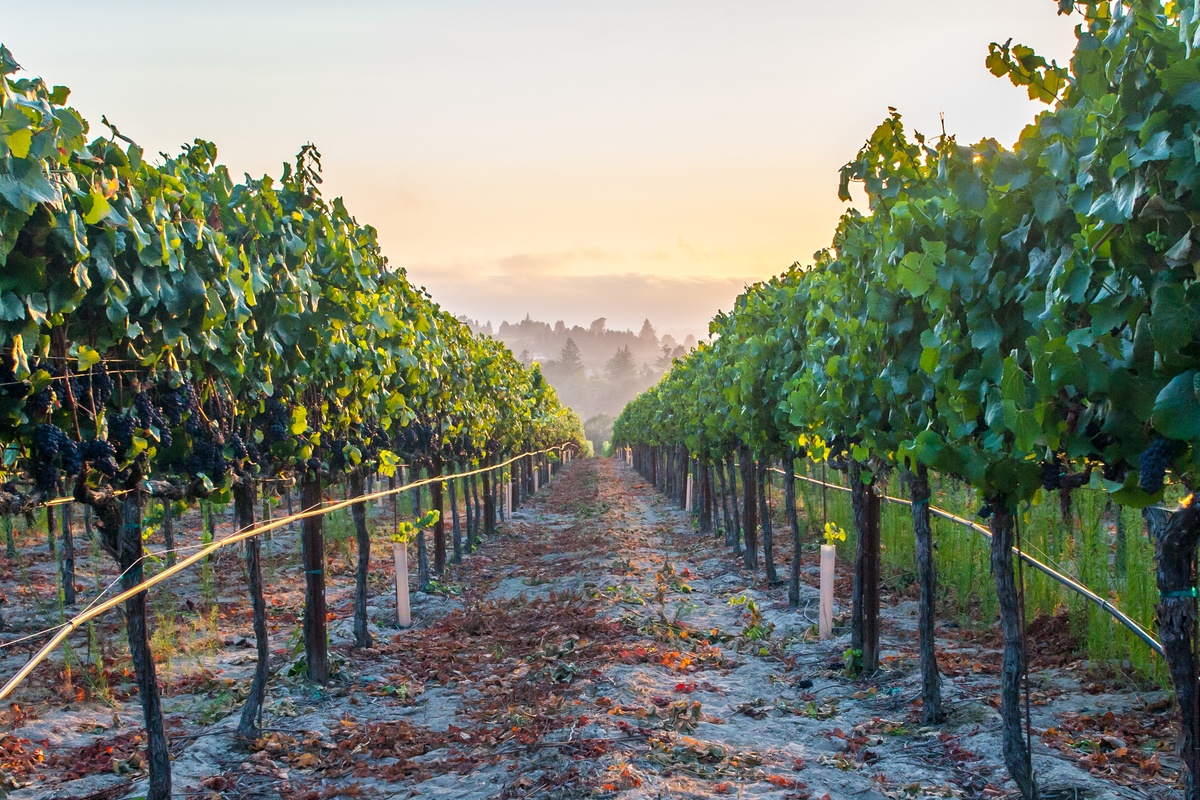
Single-Vineyard Napa Valley Cabernet Sauvignon
Each individual vineyard is alive with personality and nuance that show through in every vine and every grape. These single-vineyard wines best reflect the Cabernet Sauvignon characteristics of each vineyard. Our grapes are grown in some of the most coveted vineyards in the Napa Valley, a collection of the finest AVAs (American Vinicultural Areas) throughout the Napa Valley. Our philosophy is to make elegant, intensely flavored, and well-balanced wines that showcase the “terroir” of each unique vineyard site. In this way, we can experience the flavor and aromas of the vineyard itself. At Castello di Amorosa every one of our wines is the pure expression of its particular vineyard. No two vineyards are alike.
Butala ♦ Morisoli-Borges ♦ Melanson ♦ Rapp Ranch ♦ Manley Lane ♦ Don Thomas
Sinalunga, Cabernet Sauvignon, Napa Valley
Cabernet Description: Sinalunga is a wine epitomizing the love, passion, quality, attention to detail, and dedication that went into the making of Castello di Amorosa. Named for the small Tuscan commune near siena which inspired Dario Sattui to construct the Castello, this Exceptional, limited-production wine is symbolic of the castle itself, a crowning achievement. The idea was to create a wine that is the best thing we’ve ever done. Put as much love in the wine as we have into the Castle and as the Monastery in Sinalunga, Italy. So we decided to name the wine Sinalunga, I hope this wine will be the epitome of everything we’ve learned, of all our love and passion for winemaking. In this way I honor Sinalunga, and all my years ive spent in Italy.
Tasting Notes: Blackberry jam, licorice and chocolate
Vineyards: A blend of the Castello’s top high-end Cabernet Sauvignon vineyards from the best growing regions of Napa Valley. Only the best vineyard blocks are used in Sinalunga production.
Featured Napa Valley AVA: This limited edition Cabernet Sauvignon is sourced primarily from top vineyards in the Rutherford AVA of Napa Valley, an area famous for producing layered and complex Cabernet Sauvignon. Rutherford AVA
Production: Extremely Limited Production
Food Pairing: This bold limited edition Cabernet Sauvignon pairs beautifully with filet mignon, roast duck, or venison with wild mushrooms.
Cellaring: Expected to easily age 20+ years.
Highest Scores/Awards: 97 Points, Jeb Dunnuck, 2018.“Lots of cassis, graphite, lead pencil, and scorched earth notes emerge from the 2018 Cabernet Sauvignon Sinalunga, another powerful, concentrated 2018 from Castello di Amorosa. One of the more structured, tannic wines in the lineup, it has full-bodied richness, a wonderfully pure, layered texture, and terrific balance. Bottles need a good 4-6 years of bottle age, but it should evolve for 30 years or more.”
Il Barone, Cabernet Sauvignon, Napa Valley
Cabernet Description: Il Barone is a very flavorful, elegant and structured red wine in the style of high-quality, very limited-production, fine Cabernet Sauvignon wines from the Napa Valley. Our Reserve Cabernet Sauvignon is sourced from our top vineyards throughout Napa Valley, and shows dense flavors of dark berries, baking spice, and powerful, structured tannins.
Tasting Notes: Enticing notes of black cherry, cassis, and dark chocolate with hints of savory spices, this full-bodied wine displays polished tannins and an elegantly balanced mouthfeel.
Vineyards: Sourced from our top vineyards throughout Napa Valley, selected vineyards change year to year depending on quality.
Featured Napa Valley AVA: The majority of the fruit comes from the Rutherford AVA, a region famed for producing beautifully structured and complex Cabernet Sauvignon.
Production : Limited Production
Food Pairing: Pair with foods as bold as the wine, such as roast game meats, grass-fed steak, or grilled portabello mushrooms with reduced balsamic vinegar glaze.
Cellaring: Expected to easily age 10-20 years
Highest Scores/Awards: 96 Points – Jeb Dunnuck – 2017 “The 2017 Cabernet Sauvignon Il Barone (there’s 5% Merlot in the blend) is a selection geared to be a rich, powerful wine and it succeeds admirably, offering full-bodied richness and depth, awesome tannin quality, no hard edges, and a complex notes of black and blue fruits, Asian spices, chocolate, and earthy, forest floor nuances. It’s another brilliant wine in this lineup.”
Trenta, Cabernet Sauvignon, Napa Valley
Cabernet Description: Trenta is an artfully crafted Cabernet Sauvignon as impressive and unique as the Castello itself. This powerful blend was aged in new French oak barrels for 30 months, a year longer than any other Castello di Amorosa reserve wine. This extended aging deeply integrates the oak to compliment the intense black fruit profile of the wine, elevating the aroma, flavor, and texture. The barrel also provides soft finishing touches which showcase the Cabernets deep flavor
Tasting Notes: velvety soft tannins and intense black cherry and currant flavors. Dense and complex with toasted oak notes that carry these fruit forward flavors throughout the finish. The additional time in the barrel provides the Cabernet with rich depth and deeper complex flavors of Caramel, Light Smoke & Hazelnut.
Vineyards: Sourced from our top vineyards throughout Napa Valley, selected vineyards change year to year depending on quality.
Featured Napa Valley AVA: Rutherford AVA & Yountville AVA – A blend of the Castello’s top high-end Cabernet Sauvignon vineyards from the best growing regions of Napa Valley. The majority of the fruit comes from the Rutherford AVA, a region famed for producing beautifully structured and complex Cabernet Sauvignon. Trenta is the only Cabernet blend that features Melanson and Don Thomas fruit, two extremely limited single vineyard wines.
Production : Extremely Limited Production
Food Pairing: Wine that should be equally as special as the meal you pair with it, live opulently with a dry-aged well-marbled beef steak with cracked black pepper.
Cellaring: Expected to easily age 10-15 years
Highest Scores/Awards: N/A
La Castellana, Super Tuscan Blend, Napa Valley
Cabernet Description: La Castellana is a harmonious blend that strikes a balance between power and elegance. Our “Lady of the Castle” is a Super Tuscan blend of Cabernet Sauvignon, Merlot, and Sangiovese, with excellent long-term aging potential.
Tasting Notes: Dark stone fruit, spices, red cherries, and floral notes are supported by silky, polished tannins.
Vineyards: Sourced from our top vineyards throughout Napa Valley, selected vineyards change year to year depending on quality.
Featured AVA: Rutherford AVA & Yountville AVA
Production : Limited Release
Food Pairing: This elegant “Super Tuscan” wine goes well with lamb, sausage, grilled steak, Venison or a great pasta dish such as Pappardelle with wild boar (Dario’s favorite).
Cellaring: Expected to easily age 10+ years
Highest Scores/Awards: 93 Points – Steve Heimoff, Wine Enthusiast Magazine – 2008 “Made from Cabernet Sauvignon and Merlot, with a splash of Sangiovese, this super Tuscan-style blend is powerful in every respect. It shows massively concentrated blackberry and crème de cassis flavors, with notes of dark chocolate and spices. The oak is rich and toasty, the tannins thick but as soft as silk, and the acidity lively enough to give all this richness a racy hit. Best enjoyed now and over the next 2–3 years for sheer Napa exuberance.”
Cabernet Sauvignon, Napa Valley
Cabernet Description: A bold and balanced Napa Valley Cabernet Sauvignon, with Excellent now but can age well for over a decade.A touch of Petit Verdot and Malbec balance the rich dark fruit and tannins of the Cabernet, adding a vibrancy to its lush mouthfeel and lingering finish.
Tasting Notes: Enticing notes of black cherry, cassis, and dark chocolate with hints of savory spice.
Vineyards: A blend of fruit from some of the best Cabernet Sauvignon growing regions in Napa Valley, including our own Diamond Mountain District estate vineyard which surrounds the Castello.
Featured Napa Valley AVA: Diamond Mountain AVA, Combsville AVA,
Production: General Release
Food Pairing: Excellent to pair with steak with cocoa and coffee rub, chicken mole, or grilled meats.
Cellaring: Potential to age 10+ years
Highest Scores/Awards: 2018 – 93 Points – James Suckling “A rich, layered red with ripe berry, plum and some cedar and oak. It’s medium-to full-bodied with chewy tannins and a medium austere finish. Some toast and bitterness at the end. Give it time to open. Try after 2022.”
Quattro, Cabernet Sauvignon, Napa Valley
Cabernet Description: A blend of Cabernet Sauvignon fruit from four top vineyards all co-fermented in a single tank, this powerfully-structured, limited production Napa Valley Cabernet was a result of our winemaking team’s quick thinking, and a tribute to the record 2017 harvest season.Quattro is the result of the winemaker’s instinct, quick thinking, and a little bit of luck. On October 15, 2017, after harvesting Cabernet Sauvignon from 4 of the Castello’s top vineyards, a small quantity from each was left over due to the 4 intended fermentation vessels coming full. Knowing that the fruit was all of great quality, he decided to ferment the leftovers together in a single small tank. Upon tasting the wine just as the fermentation was finishing up, we knew something special had occurred, and we proclaimed that the “Quattro” warranted a unique bottling. No blending has been done with this wine since that fateful day the grapes were plucked from the 4 distinct vineyard sites from across the Napa Valley
Tasting Notes: Enticing notes of black cherry, cassis, and dark chocolate with hints of savory spice.
Vineyards: Dependent on Season
Featured Napa Valley AVA: Diamond Mountain AVA, Combsville AVA, Rutherford AVA,
Production: Extremely Limited Production
Food Pairing: Excellent to pair with steak with cocoa and coffee rub, chicken mole, or grilled meats.
Cellaring: Expected to cellar 7-12+ years.
Highest Scores/Awards: N/A
Diamond Mountain, Cabernet Sauvignon, Napa Valley
Cabernet Description: A single vineyard Cabernet Sauvignon grown in the volcanic soils of the hillside vineyards surrounding the Castello in the Diamond Mountain District AVA. Meant for cellaring up to 10 years.The Diamond Mountain District is one of the northern-most growing regions in Napa Valley, and is home to Castello di Amorosa. The volcanic soils and sloped landscape characteristic of the mountain limit grapevine growth leading to an especially concentrated Cabernet Sauvignon.
Tasting Notes: The volcanic soils of this hillside vineyard give this Cabernet Sauvignon a firm structure, with intense notes of blackcurrant, cassis and green olive. Bold yet with a supple texture and balanced tannins, this wine shows layers of ripe cherry, juicy berry flavors and cedar.
Vineyards: Villa Amorosa surrounding Castello di Amorosa, This 30 acre estate vineyard surrounds the Castello in the rolling foothills of the Diamond Mountain District. The unique, porous volcanic soils and extended sun exposure above the fog line help to produce rich and powerful Cabernet Sauvignons with chewy textures and diamond-hard tannins.
Featured Napa Valley AVA: Diamond Mountain AVA
Production: General Release
Food Pairing: Food Pairing Notes Excellent to pair with steak with cocoa and coffee rub, chicken mole, hearty mushroom dishes or grilled meats.
Cellaring: Expected to Cellar 10-15 Years.
Highest Scores/Awards: 94 Points, Wine Advocate, 2013 “In the Napa Valley, hillside vineyards of Diamond Mountain District, Howell Mountain, Mt. Veeder, Spring Mountain District have thinner, less fertile soils which produce smaller berries with more intense flavors, reminiscent of Bordeaux style wines that require years of aging to mature. The yields are also much lower, 1–2 tons per acre in contrast to the 4–8 tons that can be produced in the more fertile valley floors. Wines produced from mountainside vineyards tend to be characterized by deep inky colors and strong berry aromas. The best.”
Rutherford, Cabernet Sauvignon, Napa Valley
Cabernet Description: This elegant Limited-Edition 2018 Napa Valley Cabernet Sauvignon Excellent now but can age well for over a decade. It displays traits of a classic earthy tone, a characteristic that is common among Cabernet Sauvignon made in the Rutherford region.
Tasting Notes: displays hints of black cherry, savory spices and hints of minerals. It displays traits of a classic earthy tone, a characteristic that is common among Cabernet Sauvignon made in the Rutherford region.
Vineyards: Rutherford
Featured Napa Valley AVA: Rutherford AVA,
Production: Limited
Food Pairing: Excellent to pair with steak with cocoa and coffee rub, chicken mole, or grilled meats.
Cellaring: Expected to Cellar
Highest Scores/Awards: N/A
Howell Mountain, Cabernet Sauvignon, Napa Valley
Cabernet Description: With elevations of 1,400 to 2,200 feet, Howell Mountain Cabernets are some of the most concentrated wines in the world. The shallow volcanic soils results in struggling vines, thus resulting in small clusters of tiny grapes. The smaller grapes have a higher skin-to-juice ratio resulting in more complex tannis, adding unique flavors throughout the wine. This elegant Limited-Edition Napa Valley Cabernet Sauvignon displays hints of cassis, spice, black currant, and cherry flavors. Excellent now but can age well for over a decade.
Tasting Notes: Enticing notes of black cherry, savory spices and hints of minerals.
Vineyards: N/A
Featured Napa Valley AVA: Howell Mountain AVA,
Production: Limited
Food Pairing: Excellent to pair with steak with cocoa and coffee rub, chicken mole, or grilled meats.
Cellaring: Expected to Cellar 10+ Years.
Highest Scores/Awards: N/A
Grigsby Vineyard, Cabernet Sauvignon, Napa Valley
Cabernet Description: This limited-release Cabernet was grown in the Yountville AVA. This single-vineyard cab benefited from the AVA’s rocky, well-drained soils and a long growing season that allowed the fruit time to develop unique flavor characteristics. A complex and full-bodied wine with classic notes of black cherries, warm plums and ground herbs. ints of black cherry, savory spices and hints of minerals. It displays traits of a classic earthy tone, a characteristic that is common among Cabernet Sauvignon made in the Youtville region.
Tasting Notes: A complex and full-bodied wine with classic notes of black cherries, warm plums and ground herbs.
Vineyards: Grigsby Vineyard
Featured Napa Valley AVA: Combsville AVA,
Production: Limited
Food Pairing: Excellent to pair with steak with cocoa and coffee rub, chicken mole, or grilled meats.
Cellaring: Expected to Cellar 10+ Years.
Highest Scores/Awards: N/A
Coombsville, Cabernet Sauvignon, Napa Valley
Cabernet Description: Released only in 2017. This limited-time Cabernet Sauvignon displays characterisitcs typical of the Coombsville growing region. Rich earthy notes and mineral flavors give way to a more fruit forward taste. Characterized by its soft but significant tannins, which provide superior mouthfeel. A sophisticated and layered wine filled with complex contrasts. Drink now through 2025.Classic earthy and mineral notes on display.Vineyard Notes
Tasting Notes: Enticing notes of dark fruits, earthy notes and mineral flavors
Vineyards: Wines from the Coombsville AVA can be recognized by their typically soft but significant tannins, which provide structure with underlying layers of earth and minerality. Coombsville is the first place the fog rolls in from the San Pablo Bay and the last place it leaves. This allows the grapes to have long, slow ripening period as vines bud early and grapes are usually among the last to be harvested in the Napa Valley.
Featured Napa Valley AVA: Combsville AVA,
Production: Limited
Food Pairing: Excellent to pair with steak with cocoa and coffee rub, chicken mole, or grilled meats.
Highest Scores/Awards: N/A
Single-Vineyard Wines
These single-vineyard wines best reflect the characteristics of each unique vineyard. Our grapes are grown in some of the most coveted vineyards in the Napa Valley, a collection of the finest AVAs (American Viticultural Areas) throughout the Napa Valley.
Butala, Cabernet Sauvignon, Napa Valley
Cabernet Description: Among our most limited edition wines at The Castle is our Butala Cabernet Sauvignon. Available exclusively through our Butala Club Program. This Limited Edition, single-vineyard Cabernet Sauvignon is sourced from Butala Vineyard, located in the legendary Coombsville AVA of Napa Valley. An exceptional Napa Valley Cabernet Sauvignon with excellent long-term aging potential. This estate vineyard has a very rocky, red volcanic soils and steep hillside slopes. These wines produced a small crop of highly concentrated & structured fruit. The soft tannin structure, unique to Coombsville fruit, can be attributed to the hang-time, which is the longest of any appellation in Napa.
Tasting Notes: Highlighted by flavors of earthy chocolate, black currant & with blackberry aromas.
Vineyards: Butala Vineyard in Coombsville AVA. Located in the legendary Coombsville AVA of the Napa Valley. This estate vineyard has a very rocky, red volcanic soil inhabited by the volcanic sedimentary rock and lava flows formed by the Vaca Range on the eastern side of the Napa Valley.
Featured Napa Valley AVA: Coombsville AVA
Production: Available by Allocation Club Only
Food Pairing: Ideal to pair with filet mignon or beef short ribs.
Cellaring: Expected to easily age 20+ years
Highest Scores/Awards: 2016 – 96 Points – Jeb Dunnuck – “Leading off with the 2016 Cabernet Sauvignon Butala Vineyard, which is a blend of 87% Cabernet Sauvignon, 5% Merlot, 7% Malbec, and 4% Petit Verdot, it reveals a saturated purple color as well as a beautiful bouquet of sweet crème de cassis, blueberries, exotic flowers, orange blossom, and subtle background oak. This medium to full-bodied, elegant, beautifully polished effort is perfectly balanced, has no hard edges, and offers a great finish. It falls into the pretty, elegant end of the spectrum, yet it still has fabulous intensity and length. Drink 2019 – 2039.”
Manley Estate Vineyard, Cabernet Sauvignon, Napa Valley
Cabernet Description: Our newest Castello Estate just had its first harvest in 2021! We are very excited to see the results it produces. So far, so good as the fruit looked amazing as it rolled through the crush pad.
Tasting Notes: Expect to see classic notes displayed in the Rutherford floor AVA.
Vineyards: Manley Estate Vineyard located in the Rutherford AVA.
Featured Napa Valley AVA: Rutherford AVA, Manley estate lies in the heart of Napa Valley just in the Rutherford Bench, home to the famed Rutherford AVA. Known for producing some of the best Cabernet in the world.
Production: N/A
Food Pairing: N/A
Cellaring: N/A
Highest Scores/Awards: N/A
Morisoli-Borges Vineyard, Cabernet Sauvignon, Napa Valley
Cabernet Description: The Morisoli Family started growing grapes in western Rutherford around 1900. This wine comes from a blend of these “old” and “young” blocks, and it expresses the Rutherford appellation’s famous “dust” character, with its unique soft, silky tannins.
Tasting Notes: The silky Cabernet shows hints of blueberries, blackberry jam, cassis, and graphite. The silky Cabernet shows hints of blueberries, blackberry jam, cassis, and graphite.
Vineyards: Morisoli-Borges Vineyard located on the Rutherford Valley Floor.
Featured Napa Valley AVA: Rutherford AVA, This elegant single-vineyard Cabernet comes from the legendary Rutherford AVA in The Napa Valley.
Production: Extremely Limited Production
Food Pairing: Pair with foods as bold as the wine, such as roast game meats, grass-fed steak, or grilled portabello mushrooms with reduced balsamic vinegar glaze.
Cellaring: Expected to Cellar 10-20 Years.
Highest Scores/Awards: 2014 – 96 Points – Robert Parker, The Wine Advocate “Coming from the valley floor, the 2014 Cabernet Sauvignon Morisoli-Borges Vineyard hails from the tenderloin of the so-called bench area. It shows gorgeous fruit, loads of blueberry, blackberry and cassis notes, licorice and incense followed by an opulent, voluptuously textured, super-sexy style with oodles of glycerin, fruit and extract. This is a stunner and irresistible already. Moreover, it should age nicely for another 15 or more years.”
Melanson Vineyard, Cabernet Sauvignon, Napa Valley
Cabernet Description: This limited release wine is a wonderful example of the unique terroir of Pritchard Hill, touted for its steep, well-drained sloped and rugged volcanic soils. This wine will age elegantly for the next 10-15 years.
Tasting Notes: Inky black in color, black fruit aromas and earthy notes show the intensity and character of this wine. Intense fruit is framed by a very sturdy and age worthy tannin structure. Inky black in color, velvety tannis, black fruit aromas and earthy notes show the intensity and character of this site.
Vineyards: Located in hillside vineyards near the town of St. Helena.
Featured Napa Valley AVA: Vineyard rests high (1,200 ft) on the Eastern hills of the Napa Valley overlooking Saint Helena. The location, known as Pritchard Hill, is touted for its steep, well-drained slopes and rugged volcanic soils. Melanson Vineyard rests high on the eastern hills which overlooks Lake Hennessey in the Napa’s eastern mountains.
Production: Extremely Limited Production
Food Pairing: This bold single vineyard Cabernet Sauvignon pairs beautifully with filet mignon, roast duck, or venison with wild mushrooms.
Cellaring: Expected to Cellar 10-20 Years.
Highest Scores/Awards: 2017 – 97 Points – Lisa Perrotti-Brown, The Wine Advocate
“Made of 100% Cabernet Sauvingon, the 2016 Cabernet Sauvignon Melanson Vineyard has a deep purple-black color and stunning perfume of candied violets, chocolate-covered cherries, potpourri and menthol over a warm cassis and crushed black plums core plus a waft of garrigue. Medium to full-bodied, the palate is built like a brick house, with a firm, grainy texture and tons of freshness lifting the densely packed fruit to a good long finish. Drink 2020 – 2038.”
Rapp Ranch, Cabernet Sauvignon, Napa Valley
Cabernet Description: Long established as a premier horse ranch in the rural countryside of southern Napa Valley, is located in the heart of Coombsville. The defining characteristics of Coombsville, the newest sub-appellation in the Napa Valley, are the long, cool growing seasons that reward patient winemakers with intensely concentrated and complex wines.
Tasting Notes: is inky purple in color, with an imposing structure that frames a mouthful of savory spices, blackberries, and wild herbs. The tannins are silky and smooth, leading to a remarkable impression of black fruits and lingering flavors on the palate. Inky purple in color, with an imposing structure that frames a mouthful of savory spices, blackberries, and wild herbs. The tannins are silky and smooth, leading to a remarkable impression of black fruits and lingering flavors on the palate
Vineyards: Rapp Ranch located in the Coombsville AVA of Napa Valley. This fast growing AVA has shown classic traits of elite Cabernet Sauvignon vineyards. The area displays red volcanic soil inhabited by the volcanic sedimentary rock and lava flows formed by the Vaca Range on the eastern side of the Napa Valley.
Featured Napa Valley AVA: Coombsville AVA
Production: Extremely Limited Production
Food Pairing: Excellent to pair with steak with cocoa and coffee rub, chicken mole, or grilled meats.
Cellaring: Expected to Cellar 10-20 Years.
Highest Scores/Awards: 2016 – 95 Points – James Suckling “A very deep and intense wine with a gorgeous core of ripe fruit and velvety tannins and a beautiful finish. Full-bodied and flavorful. Energetic finish. Reserved. Better in 2020.”
Don Thomas Vineyard, Cabernet Sauvignon, Napa Valley
Cabernet Description: Don Thomas Vineyard is nested in the rolling hills that define the Western border of Rutherford in the Napa Valley. At every point throughout the life of this limited release wine, special consideration was given to showcase the unique Terroir of this exceptional vineyard.. This wine will age well, with it’s best years still ahead. The impeccable fruit from this sought-after hillside vineyard was hand crafted by Winemaker Brooks Painter into a single-vineyard Cabernet Sauvignon of purity and opulence.
Tasting Notes: This Don Thomas Cabernet shows exceptional character with notes of classic “Rutherford Dust”, tobacco, smoke and grilled herbs. A balanced, fruity red with mineral and berry character, plus hints of currants. Full body with silky tannins and a fresh, tangy finish. This wine shows exceptional character with notes of classic “Rutherford Dust”, tobacco, smoke and grilled herbs
Vineyards: Don Thomas is a 6 acre vineyard, planted exclusively to Cabernet Sauvignon, is nestled in the rolling hills that define the western border of the Rutherford AVA in Napa Valley. Located at the valley’s widest point, Rutherford receives more sunlight during the day than other parts of the valley. This, combined with a wide variance of daytime to nighttime temperatures (average fluctuation of 12 degrees in the summer months) allows the fruit to ripen at a steady pace, and helps to make the Rutherford AVA the most famous of Napa Valley’s nested appellations for growing Cabernet Sauvignon.
Featured Napa Valley AVA: Rutherford AVA
Production: Most Limited Single-Vineyard Wine
Food Pairing: Pair with foods as bold as the wine, such as roast game meats, grass-fed steak, or grilled portabello mushrooms with reduced balsamic vinegar glaze.
Cellaring: Expected to Cellar 20+ Years
Highest Scores/Awards: 2016 – 96+ Points – Lisa Perrotti-Brown, The Wine Advocate
“Composed of 100% Cabernet Sauvignon, the 2016 Cabernet Sauvignon Don Thomas Vineyard is deep purple-black in color and features vibrant notes of crushed wild blueberries, black raspberries and red and black currants with wafts of rose hips, raspberry leaves, unsmoked cigars and pencil shavings. Medium to full-bodied, the palate is tautly structured with ripe, grainy tannins and beautiful freshness framing the red and black fruit layers, finishing long and mineral laced. Drink 2020 – 2039.”
15th Anniversary

Bradley Aden
Our 15th Anniversary!
Our 15th Anniversary is here! We are pleased to announce our 15th anniversary here at Castello di Amorosa. To our loyal Amici del Barone Wine members and those of you that enjoy our wines as a part of your celebrations, we offer our sincere thanks for your support throughout the years. Many of you know that Castello di Amorosa was a 30-year labor of love; a culmination of my life’s dream to build an authentically styled Tuscan castle in the Napa Valley where I could make outstanding Italian-style wine.
“I am extremely pleased with the Castello’s contributions to the world of wine and wine tourism. I set out attempting to create an extraordinary winery and today it is extremely rewarding to see so many customers enjoying the Castello and our wines,” Sattui is a committed philanthropist who has supported numerous causes in the Napa Valley and beyond—from endowing a new school and Boys & Girls Club in Calistoga, funding heart research to donating land to the Land Trust in Sonoma County.
Castello di Amorosa has been recognized as one of the most visited wineries in the world. Among its many honors, it was chosen as The Best Tasting Room in America by USA Today in 2020 and in March of this year it was identified as the most Instagrammed winery in the world, according to research by TheThinkingTraveller travel company.
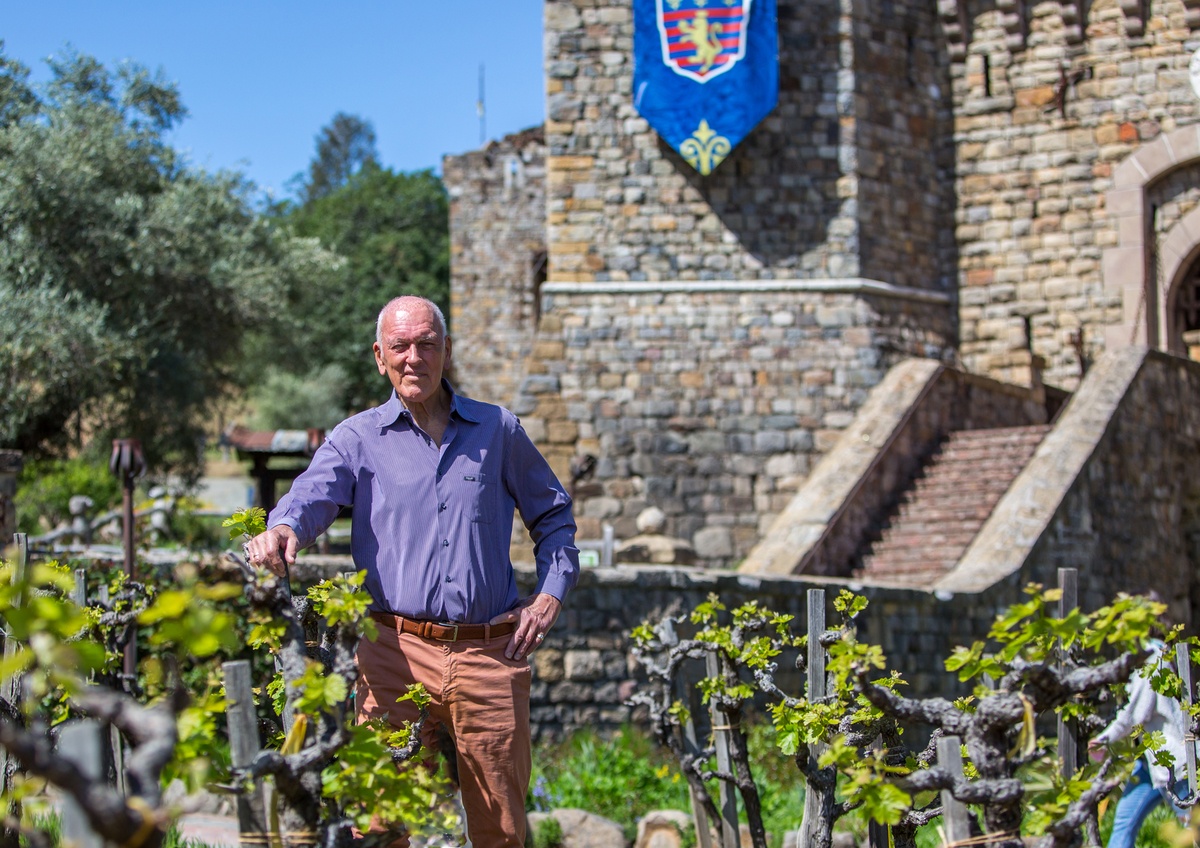
Other accolades include being recognized as one of “Napa’s Most Beautiful Wine Tasting Rooms” by Food & Wine Magazine, as “Best Wine Tasting Room” by North Bay Bohemian, as “Best Place to take visitors” by KVON Radio, as one of the “Top 5 Romantic Spots in the Napa Valley” and as one of “Ten Most Intriguing Architectural Wineries in Napa” by Napa Valley Life Magazine, in addition to receiving several Certificates of Excellence from Trip Advisor.
The Castello suffered an enormous setback in October of 2020, when a detached building of the Castle was destroyed by the Glass Fire: Sattui and his team are bent on restoring it just the way it was. Estimated completion of the restored wing is late 2023.
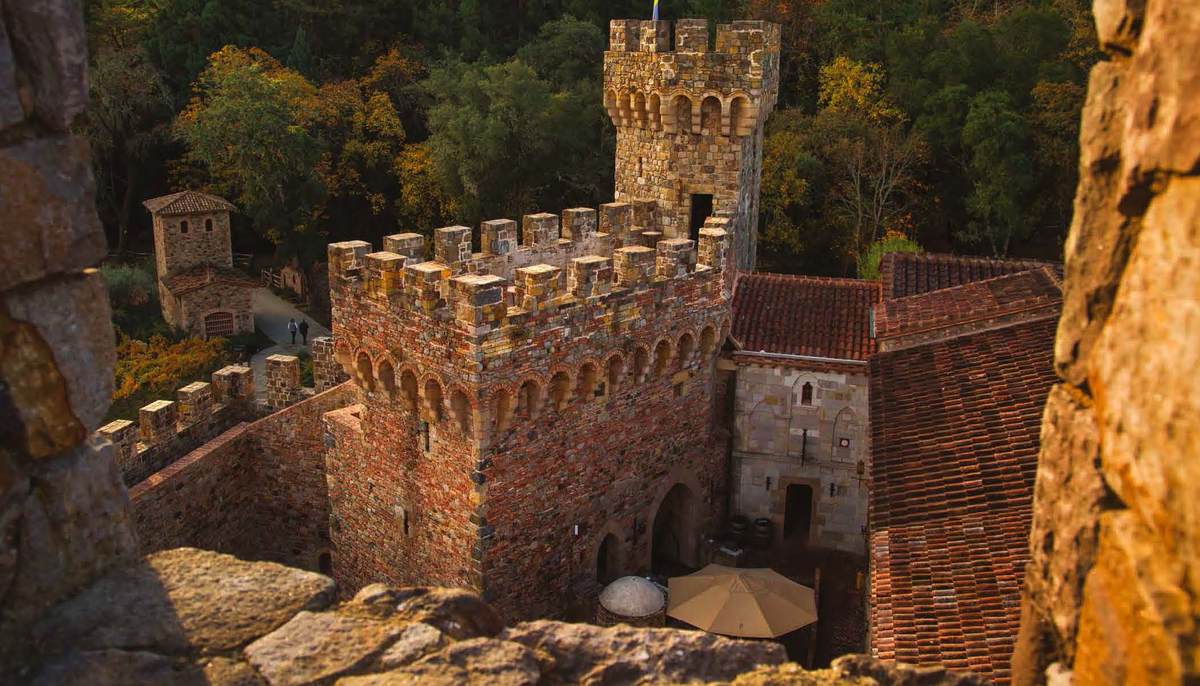
Castello di Amorosa used materials such as antique, handmade bricks and roof tiles, hand-hewn timbers, hand-forged iron gates, lamps and hardware and medieval construction techniques and over 8,000 tons of hand-chiseled local stone to create this architectural gem. Sattui designed most of the winery himself; it is not a replica of a medieval castle but rather a uniquely conceived one-of-a-kind building. The 150,000 square-foot castle / winery consists of four floors above ground and five floors below ground. It encompasses five defensive towers with battlements, 1,000-pound hand-hewn doors from Italy, a Great Hall with a 22-foot coffered ceiling featuring hand-painted frescoes inspired by medieval Italian frescoes. The castle’s 12,000 square foot Grand Barrel Room features 40 Roman cross-vaults in its brick ceiling. All of the ironwork was hand-forged by Italian artisans over open flames on site during the construction. Over 170 containers of handmade antique bricks, roof tiles and antique furniture were brought from Italy for the building. Additional authentic features include multiple courtyards, a chapel, the drawbridge, a watch tower, a torture chamber and secret passageways.
The winery itself is a modern contrast to the Castello as a whole. It contains advanced crushing and fermentation facilities, five underground levels and 24,000 square feet of caves all for barrel aging. Winemakers Brooks Painter and Peter Velleno have a wide range of equipment available to them, ranging from custom-designed triple-jacketed cooling fermentation tanks to concrete/ceramic eggs. Read more below about the construction of the Castle.
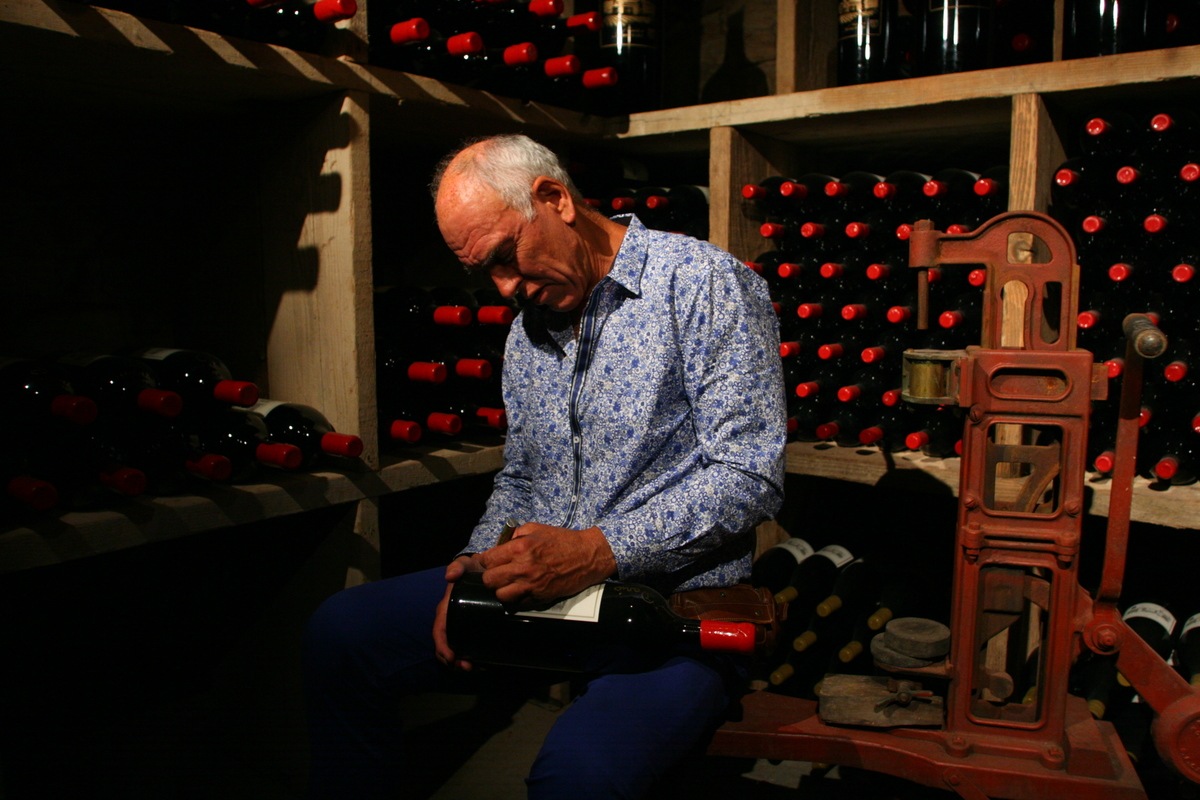
In 1993, I purchased the spectacular property upon which I built Castello di Amorosa. It sat on a hundred-seventy beautiful acres of forest and hills with a stream, a lake, one of the first houses built in Napa County and a great Victorian home where I chose to live. It was my dream property, culminating a search of many years. The purchase also came with a great building permit for a large winery building which had taken the previous owner thirteen years to obtain.
My initial intent was to build an 8,500 square-foot building without cellars. (Gradually it morphed into 121,000 square feet with 107 rooms with four separate levels underground and four levels above!) After more than 15 years of research, I was ready to build my castle in the Napa Valley.
I had accumulated a wealth of knowledge on medieval architecture, a huge library of books, photos, plans and detailed sketches. I couldn’t wait to get started. The renovation of my historic Victorian at the bottom of the hill on the same property would have to wait. I was going to build my castle first.
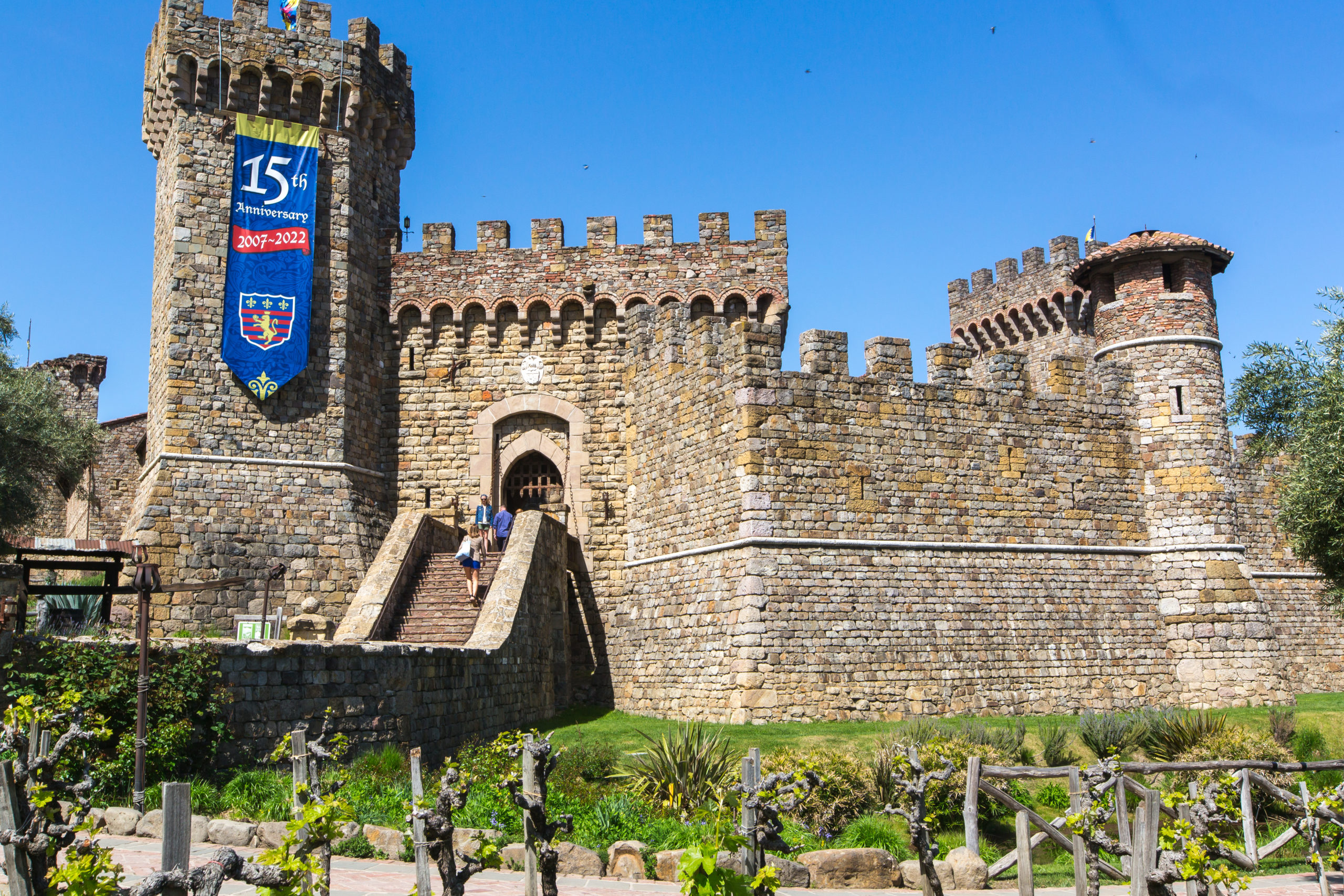
Within a short time of acquiring property on which I would build, Lars Nimskov, the naval architect from Denmark, came from Italy and we began working on plans which were submitted and approved by Napa County a year later.
Castello di Amorosa appears to be an authentic castle for one reason only: it is an authentic castle, though fancified. We either used construction methods and materials that would have been used 1,000 years ago, or we used very old hand-made materials that had survived up to modern times. A fireplace predating Christopher Columbus adorns the Great Hall, and Iron Maiden from the late Renaissance dominates the torture chamber. A wrought iron dragon from the times of Napoleon hovers over the massive main door. More than 8,000 tons of stone were chiseled, not sawed, by hand to be absolutely authentic. Nearly 200 containers of old, hand made materials were shipped from Europe to lend authenticity.

Finally, we were able to open on April 7, 2007. I had no idea if the project would be well-received or not. Would I be laughed at or would people respond positively? The first few days after opening gave me hope. The response to both the Castle and our wines was overwhelmingly positive.
When we opened the doors fifteen years ago, I wondered how my castle would be received, as it was so unorthodox a concept. Today we have a collection of superb estate vineyards and highly acclaimed wines. Just recently our Morisoli-Borges Cabernet Sauvignon received 98 points from Jeb Dunnuck and our single-vineyard Melanson Cabernet Sauvignon received 97 points from The Wine Advocate. Our wonderful guests respect and enjoy the fact that our wines are only available at the winery or can be shipped directly to your home or business.
Thanks to you, my dreams have come true. Both the Castello and the wines have received great reviews. I encourage everyone to come visit and celebrate our 15th year in business. Thank you again for your continued support. We invite you to come visit and help celebrate our 15th Anniversary in the Napa Valley.
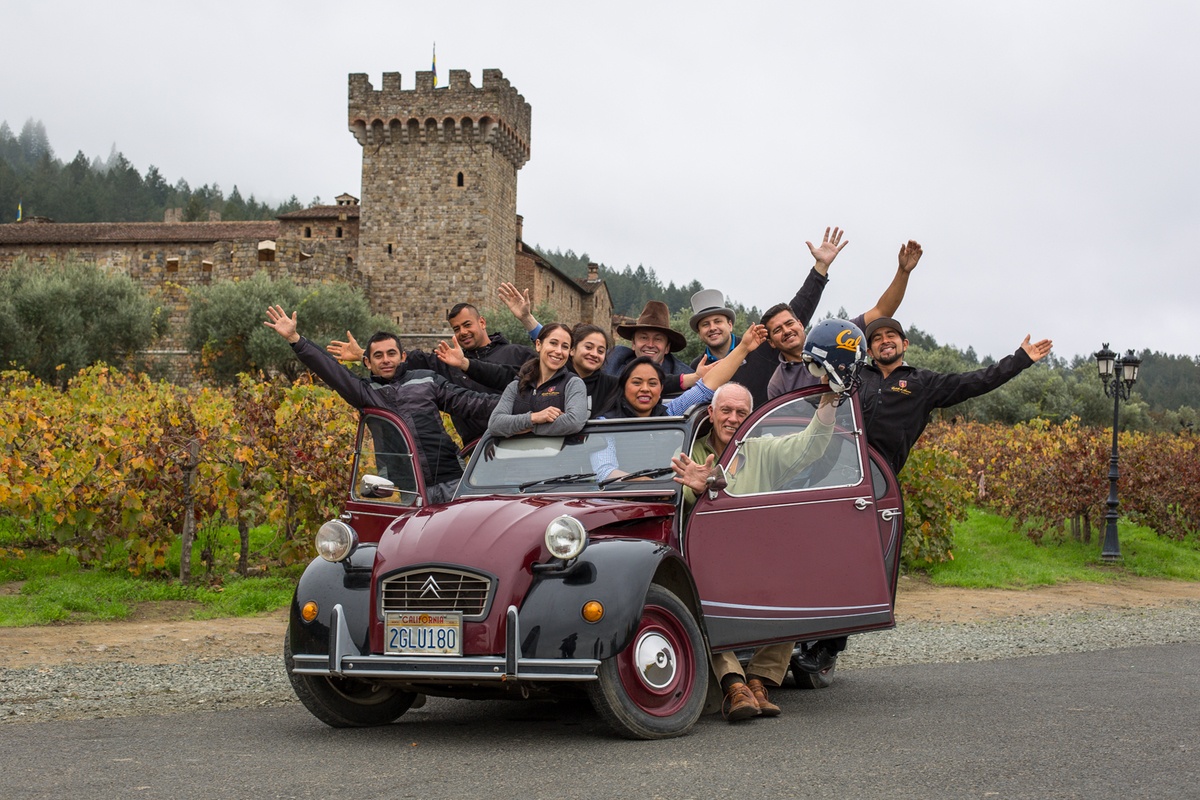

♦ Solar Grid Installed
We invested $1.4 million in a 450-kilowatt solar power array.
♦ Disney Films The Quest
During Covid-19 The Quest was filmed on location at Castello di Amorosa.
♦ Manley Estate Vineyard Acquired
Located in the Rutherford AVA of Napa Valley, we hope to get our first Manley Estate vintage in 2025.
♦ Castello Closed for 1st Time
Covid 19 & The Glass Fire forced us to close the Castello for the first time.
♦ Named Best Tasting Room in America
Voted Best Tasting Room in America by USA Today’s 10 Best.
♦ The Castle Hosts Festival Napa Valley
Breathtaking performances in iconic wine country, are paired with Napa Valley’s unparalleled food, wine and hospitality. Festival Napa Valley offers programs that uplift and inspire, and attract artists and audiences from around the world. The annual July celebration raised $2.6 million, a new record.
♦ We Celebrated Our 10th Anniversary
In 2017 we celebrated our 10th year in business.
♦ Highest Scoring Wine to Date
Our 2017 Melanson was scored 98 by Wine Enthusiast Magazine.
♦ Our Popular Butala Estate Club Established
2016 was the year we purchased Butala vineyard from Letterman star headman Tony Butala. Our estate club of the same name was established the same year.
♦ Brooks Painter Named Winemaker of The Year
Our head winemaker Brooks Painter was named head winemaker of the year in 2014 by The American Fine Wine Competition.
♦ 1st Vintage of our Acclaimed Cabernet Sinalunga
2012 marked the first year that we made our ultra premium Cabernet Sauvignon Sinalunga, inspired by the abandoned Castles from the Sinalunga countryside.
♦ Pixar Movie Brave Premier at The Castle
The event saw a total of 2,400 people attend a screening of Brave.
♦ Named Best Restroom in America
Winners of the 10th annual Best Restroom in America contest.
♦ Grape Juice Program Starts
We wanted to do something special and offer something to the non-alcohol drinkers & children that come visit Castello di Amorosa each and every year.
♦ Bachelor TV Show is Filmed
The popular television show The Bachelor was filmed at the Castle in 2008.
♦ Our Beloved Goat Giacomo Rescued
“This is dense and intense with a beautiful velvety texture and ripe fruit, but it remains fresh and clean. Full body. Textured finish. Better in 2016.”
♦ Pagan Ball & Masquerade Ball
We started two beloved events at the Castle.
♦ Bedtime Stories Movie is Filmed
“SBedtime Stories was filmed at the Castello in 2008 staring Adam Sandler.
♦ The Castello Opens
Construction is completed and we have our first paying customers.
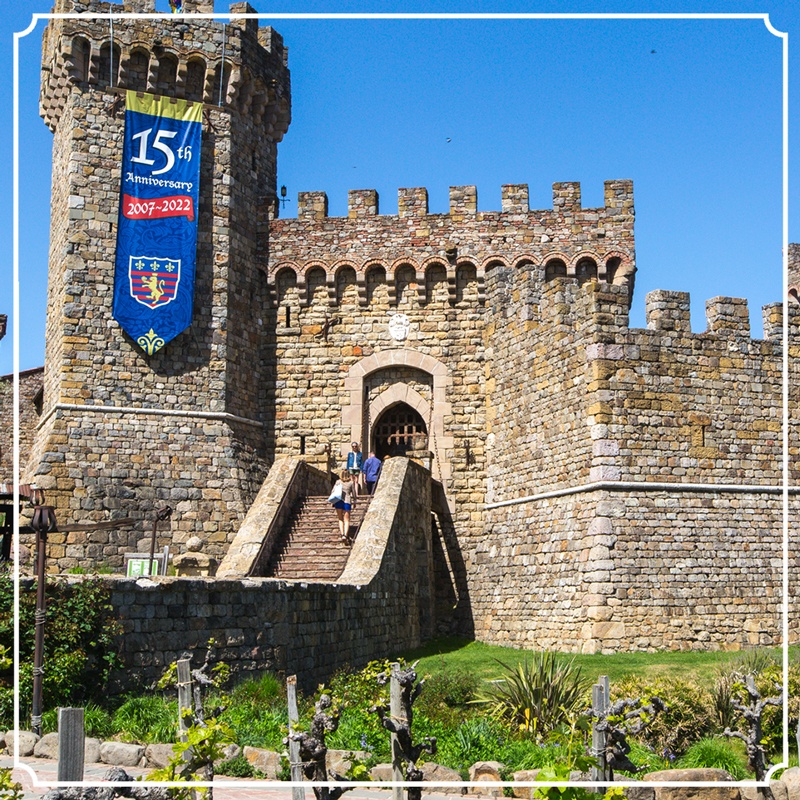
Highest Scoring Sweet Wine Ever

Bradley Aden
For The Love of Late Harvest!
We want to take the time & celebrate our highest scoring sweet wine in Castle History, our 2019 Late Harvest Gewürztraminer. Hailing from our Boonville Ranch Vineyard, this wine was awarded a 95 Point, Cellar Selection by Wine Enthusiast Magazine.
Please join us in congratulating our entire winemaking team, including head winemakers Brooks Painter & Peter Velleno for their hard work. Special thanks to our vineyard manager David Bejar who oversees Castello properties year-round.
95 Point – Cellar Selection, Wine Enthusiast Magazine
“Dripping with honey, apricot and poached pear flavors, this luscious and extremely sweet wine coats the palate and lingers for minutes on the finish. It’s a delicious, low-alcohol indulgence that is made from late-harvest grapes shriveled on the vine. Best through 2030. Cellar Selection”
Late Harvest Wine Notes
Tasting Notes: A succulent and deliciously spicy white wine loaded with aroma and flavor, made in a “Noble Rot” dessert, or very sweet, style. Deep straw in color, the wine displays hints of peach, apricot and toffee with a undertone of honey.
Late Harvest Notes: Typically harvested at nearly 32 Brix or more with residual sugar levels close to 13%, this succulent dessert wine is a perennial favorite. A regal dessert wine made from overripe grapes which develop Botrytis cincerea, or “Noble Rot”, shriveling the skins and enhancing sugar, acid and flavor intensity. The resulting harvest in late autumn is vastly diminished in yield, resulting in more concentration and flavor. Made in the style of some of the world’s greatest dessert wines, such as Sauternes and the “dried grape” white wines of Sicily such as “Passito di Pantelleria”.
Food Pairing: Ideal with after dinner desserts of chocolate torte, crème brulee or baked fruit with an artisanal cheese selection.
Past Awards:
2013 Vintage – 92 Points “Editor’s Choice” Wine Enthusiast Jim Gordon
2014 Vintage – SF Chronicle Wine Competition Best of Class
2015 Vintage – SF Chronicle Wine Competition Best of Class
2017 Vintage – 93 pts American Fine Wine Competition
2018 Vintage – SF Chronicle Gold Medal
Boonville Ranch, Anderson Valley
This Castello Estate vineyard is located just south of the town Boonville in Anderson Valley, a coastal valley region famed for Burgundian and Alsatian varieties. This 34 acre ranch was planted in the late 1990’s with Pinot Noir, Pinot Grigio, Gewürztraminer, and Riesling. We pick Gewürztraminer after the grapes have developed a pink to reddish hue, and the aromas are effuse with rose petals, cinnamon spice and exotic lychee fruit. We handle the fruit very carefully, avoiding the bitter tannins as much as possible.
Gewürztraminer hails from the Anderson Valley, which straddles Sonoma and Mendocino Counties. The area is breathtaking and remains quite rural. As one follows the Navarro River, it is not uncommon to spot red-tail hawks, an occasional osprey, or even, if you are lucky, a Golden Eagle. The corridor to the coast (Highway 128) and the picturesque town of Mendocino, perched on a 300-foot cliff overlooking the Pacific, are being discovered and becoming increasingly popular with tourists. Cool climate-loving grapes thrive here because of the lay of the land and strong coastal influence; it has been referred to as ‘California’s Alsace.’ Castello di Amorosa’s estate vineyard lies just to the east of Boonville. Approaching the ocean, the region becomes cooler as one moves westward. West of Boonville is a great Champagne country, but the entire area is also ideal for Riesling and Gewürztraminer.
This white wine is fruity and refreshing yet provides complexity and is appropriate as an aperitif as well as an excellent partner with aggressively flavored or spicy foods like Indian and Asian cuisines with curry or ginger. In America, we often think of Gewürztraminer in the fall when we serve spicy aromatic dishes enhanced with nutmeg, cinnamon, and clove. From our Anderson Valley estate, our winemakers concentrate on making three distinct styles of Gewürztraminer. Ranging from near dry to a sweeter desert style.
Media Kit

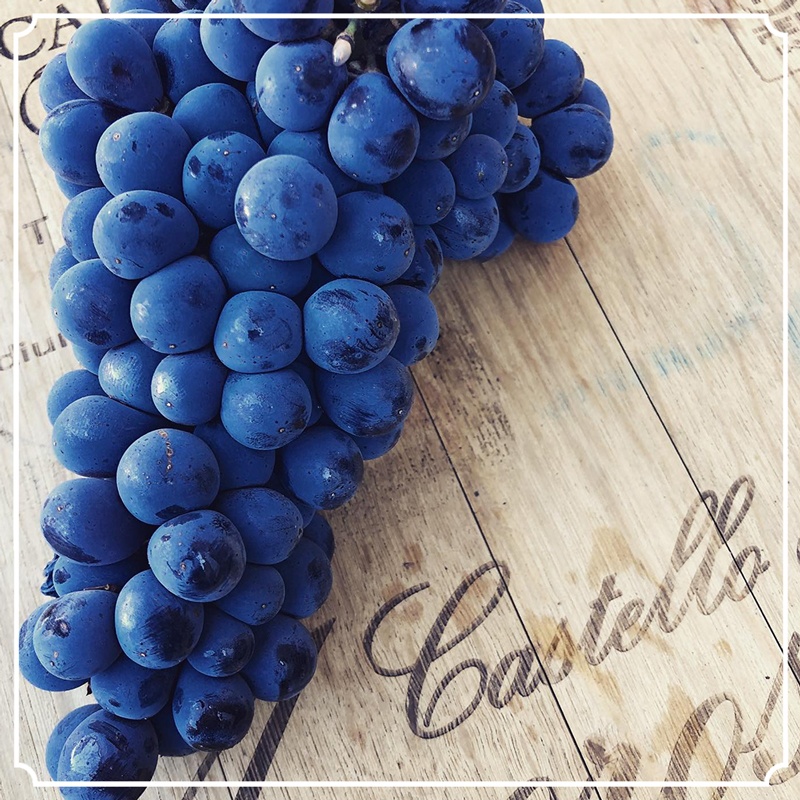
Photos
Logos
Bottle Shots
Press Release
Types of Wines
Pinot Grigio, Pinot Bianco, Vermentino, Sauvignon Blanc, Chardonnay, Gewürztraminer, Rosato di Sangiovese, Pinot Noir, Red Table Blend, Sangiovese, Barbera, Primitivo, Merlot, “Super Tuscan” Blend, Cabernet Sauvignon, Muscat Canelli, Late Harvest Gewürztraminer, Late Harvest Semillon, and Muscat Grape Juice.
Contact Us
Jim Sullivan, Vice President
Jims@castellodiamorosa.com
(707)-225-2874
Julie Ann Kodmur, Publicist
Corking@julieannkodmur.com
(707)-963-9632
The Team
Dario Sattui, Owner
March 30, 2019
Georg Salzner, President
March 29, 2019
Brooks Painter, Director of Winemaking
March 28, 2019
Peter Velleno, Winemaker
March 27, 2019
David Bejar, Vineyard Manager
March 22, 2019
Margarito Rivera, Cellar Master
March 25, 2019
Madeleine Reid, Vice President of Events and Hospitality
March 24, 2019
Audrie Walsh, Assistant Winemaker
March 2, 2024
2022 SF Chronicle Wine Competition!

Bradley Aden
2022 SF Chronicle Wine Competition – Gold Medal Wines
2022 was a great year for our wine, as we received 9 Gold Medals at the 2022 San Francisco Chronicle Wine Competition. We were also awarded Best of Class award for our 2019 Chardonnay Reserve. For a taste of our featured double gold medal wines, shop our Award Winning Wine Pack and experience these winning bottles for yourself!
Please join us in congratulating our entire winemaking team, including head winemakers Brooks Painter & Peter Velleno for their hard work. Special thanks to our vineyard manager David Bejar who oversees Castello properties year-round.
Awards from the 2022 SF Chronicle Wine Competition
There were over forty-eight judges, representing various North American wine regions, evaluating 5,816 wines from nearly 1,000 wineries for the 2022 San Francisco Chronicle Wine Competition.
Bob Fraser, SFCWC executive director, says, “The response from the wineries of North America at our 2022 competition was outstanding. Sweepstakes awards hail from California, Washington and Georgia.
We had a number of wines win Gold and Double Gold Medals, along with a Best of Class medal for our 2020 Reserve Chardonnay. Check out the complete list of award winners:
-
-
- 2019 Chardonnay Reserve – Best of Class, Chardonnay
- 2017 Il Barone, Cabernet Sauvignon – Double Gold Metal (5th Vintage in a row)
- 2015 La Castellana, Super Tuscan Blend, Napa Valley – Double Gold Medal
- 2019 Pinot Noir, Cresta d’Oro Vineyard, Sonoma County – Double Gold Medal (4th vintage in a row)
- 2019 Pinot Noir, Terra de Promissio, Sonoma County – Double Gold Medal
- 2019 Pinot Noir, Morning Dew Ranch, Anderson Valley – Double Gold Medal
- 2019 Chardonnay Reserve – Best of Class, Chardonnay
- 2016 Cabernet Sauvignon, Napa Valley – Gold Medal
- 2016 Il Passito, Napa Valley – Gold Medal
- 2018 Pinot Noir, Il Rubino – Gold Medal (3rd vintage in a row)
-
SF Chronicle Best of Class: 2019 Reserve Chardonnay, Napa Valley
SF Chronicle Wine Judge Mike Dunne, longtime SFCWC wine judge and the former food editor, wine columnist, and restaurant critic noted “Castello di Amorosa 2019 Napa Valley Reserve Chardonnay: Of course any Chardonnay that comes from a castle should be seen as being kingly and queenly, which this is in its golden luminescence, regal carriage, vivid citric fruit and ticklish spiciness. Castello di Amorosa is part of the same royal family that includes V. Sattui Winery, which also won best-of-class for a lighter but nonethess correct interpretation of Chardonnay.”
Chocolate Lovers Only

Bradley Aden
For The Love of Wine & Chocolate
Few Napa Valley wineries are committed to producing top quality chocolates. Our elegant assortment of chocolates is hand-crafted, made exclusively to pair with our wines. When paired correctly Wine & Chocolate can elevate your tasting experience into something miraculous.
Our Napa Valley chocolates are the perfect gift for any occasion, an easy way to elevate any Valentine’s Day or Christmas celebration.
A Match Made in Heaven
Chocolate and wine are two of life’s greatest pleasures, but pairing them can be a difficult. Both offer intense flavors and complexity, which can lead to challenges when pairing the two. Cocoa beans, like wine grapes, undergo the fermentation process in order to remove tannins and create a more complex end effect.
A successful chocolate and wine pairing is vivid; producing enhanced sensations and tastes across the palate. Often revealing hidden flavors in both wine & chocolate for the first time. When in doubt, pair chocolates and wines that have a similar style and weight. Less intensely-flavored chocolates go well with lighter-bodied wines, while chocolates with more intense flavors can stand up to fuller-bodied wines. While it might sound counterintuitive, a wine that is “sweeter” than the chocolate itself actually works quite well. These characteristics provide a nice balance to the bitter flavors of cocoa.
The texture contrast between the two can make the difference between an amazing pairing and a quickly forgettable experience. Is the chocolate silky, luscious, palate-coating, crunchy? The fruit flavors and tannins combine with chocolate to create a lush mouthfeel. The characteristics that work best for these pairings, lay in the contrasting elements of the wine & chocolate relationship.
Don’t forget to experience our chocolate & wine pairings, available during any Castello tour and tasting experience.
Our Favorite Wine & Chocolate Pairings
Milk Chocolate
Pairs well with Merlot, La Castellana, Super Tuscan Blend, Pinot Noir
Milk chocolate is usually sweeter and creamier with flavors of brown sugar, vanilla, and cream. It requires a wine that is light to medium in body, with a ripe fruit character.
Dark Chocolate
Pairs well with Cabernet Sauvignon, Zinfandel, La Fantasia, Il Passito, LH Gewürztraminer
Bitter to semi-sweet chocolates that are 50 to 100% cacao have intense, bitter flavors, and earthy to fruity undertones. The dark fruit from red wine and the fine tannins combine with dark chocolate to create a lush mouthfeel. Match the intensity of the chocolate without adding more dryness by pairing these chocolates with full-bodied wines.
White Chocolate
Pairs well with Riesling, Sweeter Rosè, Chardonnay
White chocolate, which is made with cocoa butter, sugar, and milk, has a sweet, buttery flavor with notes of honey and cream. Sweet white and rosè wines help cleanse the palate of the rich flavors from white chocolate, as does as sparkling spumante. White wines can really work great with white chocolate. Riesling or a buttery Chardonnay will complement the vanilla, caramel and honey flavors in the chocolate.
3 Piece Chocolate Box
Bring our wine & chocolate pairing experience home with our trio of chocolate truffles from Le Belge Chocolatier! Try our smooth and creamy milk chocolate truffle with our Napa Valley Merlot, our luscious dark chocolate crown truffle with our Napa Valley Cabernet or Il Barone, and our beautiful raspberry-filled heart chocolate with our La Fantasia. A favorite for any lover of wine and chocolate!
Each box contains:
- 1 red dark chocolate hearts with raspberry gelate & dark chocolate ganache
- 1 dark chocolate crowns w with dark chocolate and sea salt ganache
- 1 creamy milk chocolate truffle
6 Piece Chocolate Box
Bring our wine & chocolate pairing experience home with our chocolate truffles from Le Belge Chocolatier made exclusively for the Castello! Featuring two creamy milk chocolate truffles perfect to pair with our Napa Valley Merlot, two luscious dark chocolate crown truffles crafted to pair with our Napa Valley Cabernet or Il Barone, and two enticing raspberry-filled heart chocolate truffles that pair beautifully with our La Fantasia. A favorite for any lover of wine and chocolate!
Each box contains:
- 2 red dark chocolate hearts with raspberry gelate & dark chocolate ganache
- 2 dark chocolate crowns w with dark chocolate and sea salt ganache
- 2 creamy milk chocolate truffles
Fantasia Truffle Box
Satisfy your heart’s desire with this lovely box of 6 chocolate heart truffles from Castello di Amorosa. Each hand-crafted milk chocolate piece is filled with a smooth and silky raspberry ganache. Delicious on their own or when paired with our La Fantasia soft-sparkling rosé.
Each box contains:
- 2 red dark chocolate hearts with raspberry gelate & dark chocolate ganache
King’s Ransom Truffle Box
Tempt your taste buds with the “King’s Ransom” of chocolates, a jewel box containing 12 assorted pieces of our artisan chocolates. Your heart is in the right place when you purchase this for friends and family, but we wont hold it against you if you keep it!
Each box contains:
- 2 passion fruit cups with white chocolate truffle
- 2 dark chocolate crowns w with dark chocolate and sea salt ganache
- 2 dark chocolate shells with coconut truffle ganache
- 2 red dark chocolate hearts with raspberry gelate & dark chocolate ganache
- 2 white chocolate shells with key lime truffle ganache
- 2 milk chocolate truffle shells with vanilla milk ganache
Assorted Chocolate 4-Pack
Includes one bar each of our Dark Chocolate Sea Salt, Belgian Milk Chocolate, La Fantasia Raspberry Chocolate, and Hazelnut Almond Milk Chocolate. Produced by local Napa Valley chocolatier, Le Belge, exclusively for the Castello.
Sea Salt Dark Chocolate
Revel in the salty sweetness of our locally made dark chocolate sea salt bars. Enjoy all on its own for a taste sensation or serve with our Late Harvest Gewürztraminer or Il Passito for an unforgettable paring! Each bar is 64% dark chocolate blended with pure sea salt. The sea salt intensifies the bright acidic notes of the chocolate while highlighting its earthiness with a crunchy texture for a pairing that is simply divine. Produced by local Napa Valley chocolatier, Le Belge, exclusively for the Castello.
Pair With: Il Passito, Late Harvest Gewürztraminer
La Fantasia Rasberry Chocolate
Indulge in your wildest chocolate fantasies with our La Fantasia Raspberry Dark Chocolate bar. Artisanally made by a local chocolatier, this dark chocolate bar contains a delicate raspberry ganache inside; the perfect accompaniment for our La Fantasia soft-sparkling rosé wine.
Pair With: La Fantasia
Hazelnut Almond Milk Chocolate
Revel in the smooth & rich flavors of our locally made hazlenut-almond chocolate bars. A delicious nutty, toasted and earthy experience sure to wow your palate. Produced by local Napa Valley chocolatier, Le Belge, exclusively for the Castello.
Pair With: Late Harvest Gewürztraminer
Belgian Milk Chocolate
Artisanally made by local gourmet chocolatier, Le Belge, exclusively for the Castello. The chocolate exhibits everything you want in a silky, melty milk chocolate. Pair this with a soft red wine like our Merlot or La Castellana for a chocolate paring delight!
Pair With: Merlot, La Castellana, Super Tuscan Blend, Pinot Noir, Moscato, Simpatica
Wine & Chocolate Packs
Our hand curated wine & chocolate packs make the perfect gift for any Valentines Day or Christmas. Our Castello wines hand paired with an elegant assortment of chocolates hand-crafted by Le Belge Chocolatiers exclusively for the Castello, excellent to pair with your favorite Castello wines.
Featured Packs:
- The Fantasy Wine Pack – Our La Fantasia Wine Pack, available for a limited time featuring our fan favorite rosé, is guaranteed to make fireworks. This rosé wine pack features 3 bottles of 2020 La Fantasia, 4-Pack of authentic La Fantasia Raspberry Chocolate bars, 6 pc. Fantasia Truffle box & our Fantasia wine bottle magnet.
- Liquid Gold Wine Pack – An elegant take on excellence, our patience allows for a superior late harvest wine. When paired with our sea-salt chocolates this sweet wine comes to life like never before. The wine displays bright aromas of honey, vanilla bean, and citrus zest with rich butterscotch-caramel undertones. The rare late harvest varietal grown in the Yountville AVA of Napa Valley.
- Cabernet & Chocolate Wine Pack – Few things in this world go together like Cabernet Sauvignon and Chocolate. Explore the depths of taste and luxury with our limited time wine pack. An elegant assortment of chocolates hand-crafted by Le Belge Chocolatiers exclusively for the Castello, excellent to pair with your favorite Castello wines. Cabernet and chocolate are a match made in heaven! The chocolate mellows the tannins in the wine, but the rich Cabernet Sauvignon has enough structure to withstand the boldness of the chocolate.
